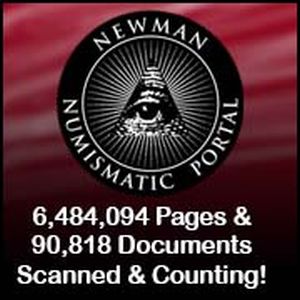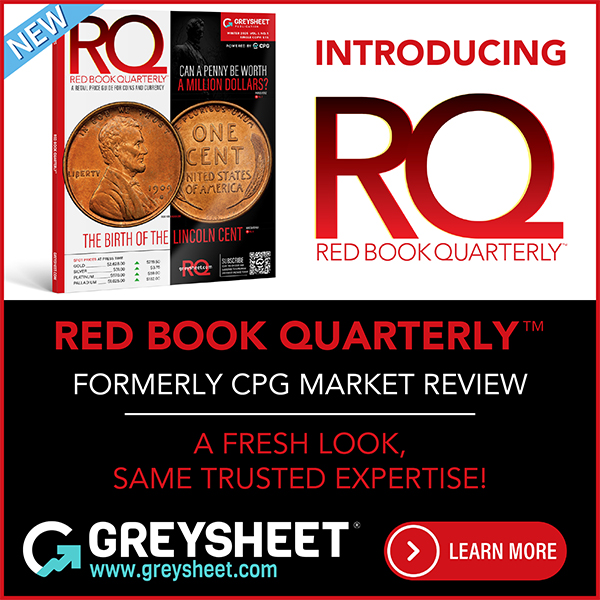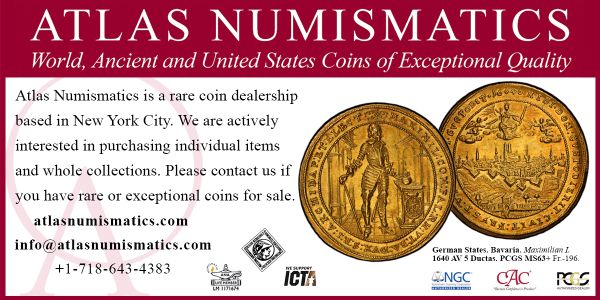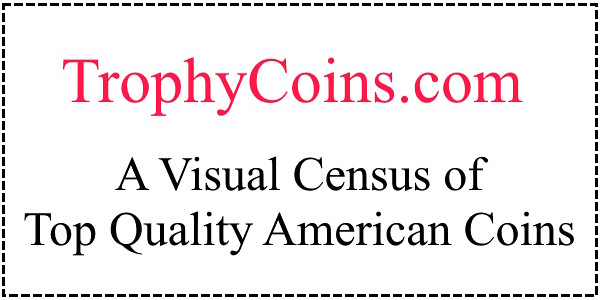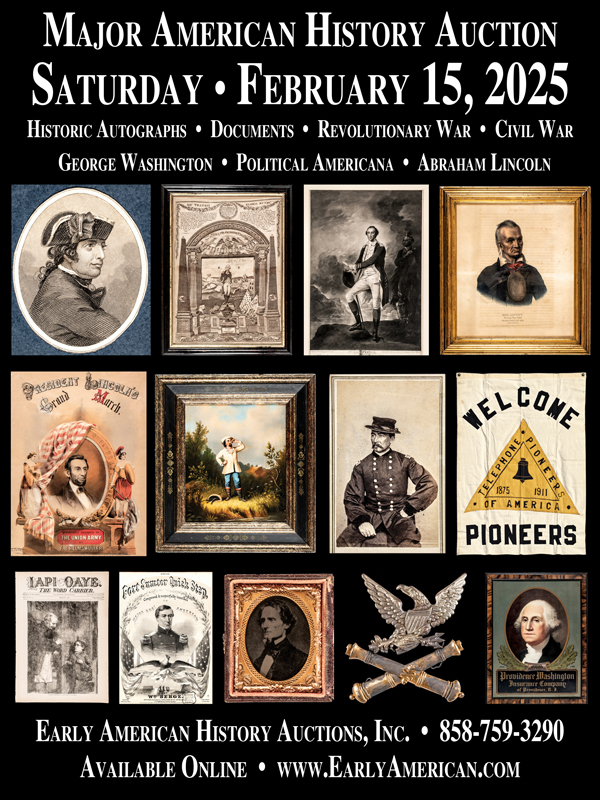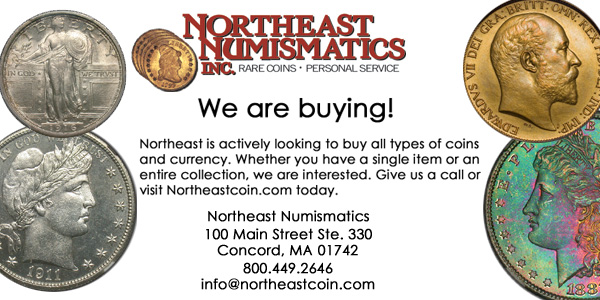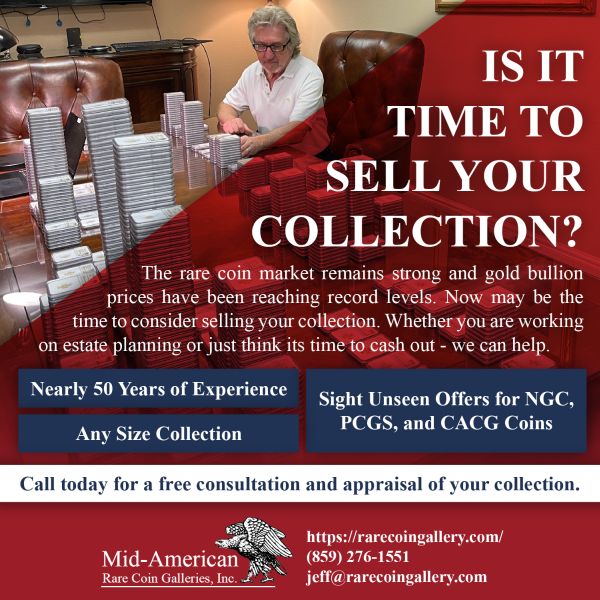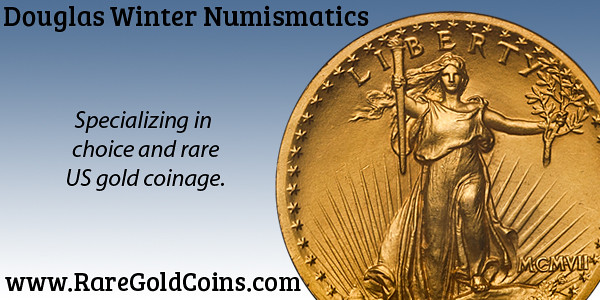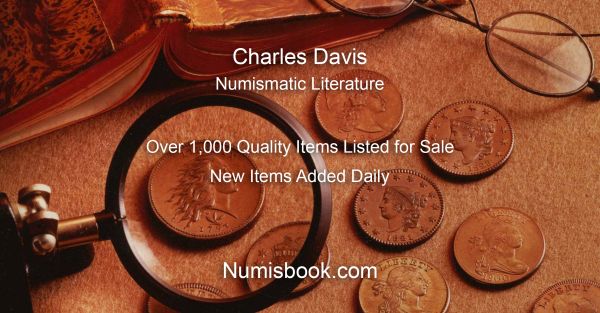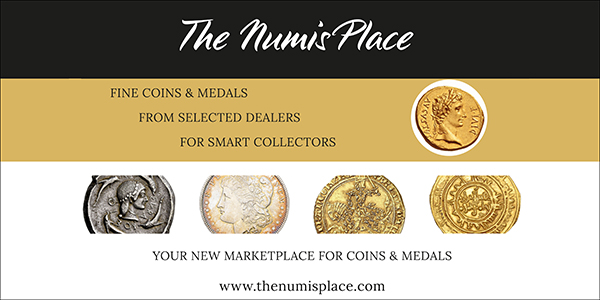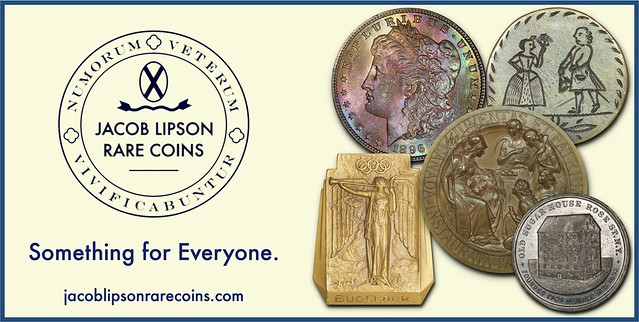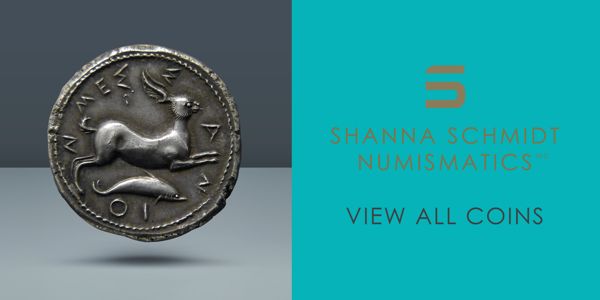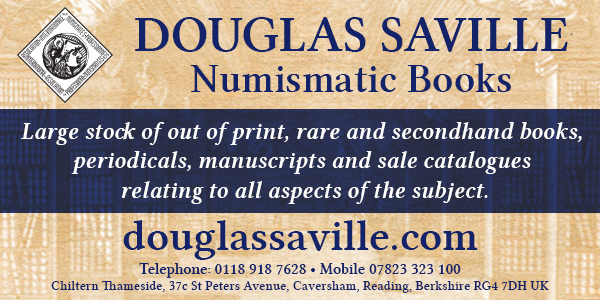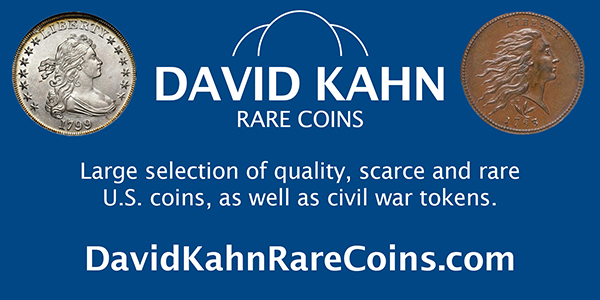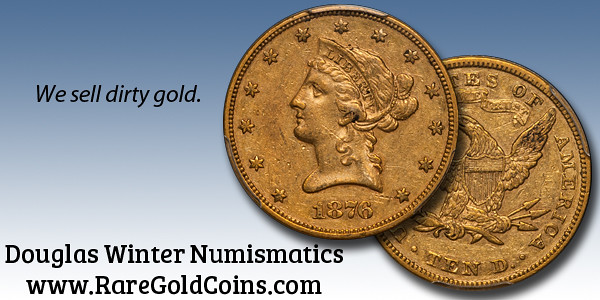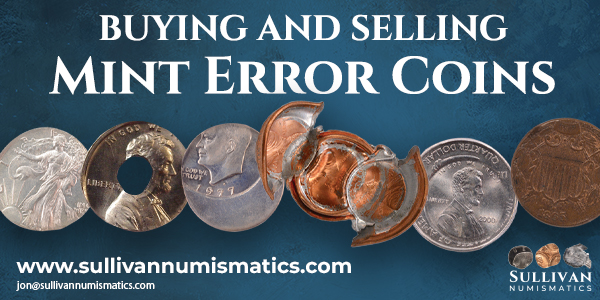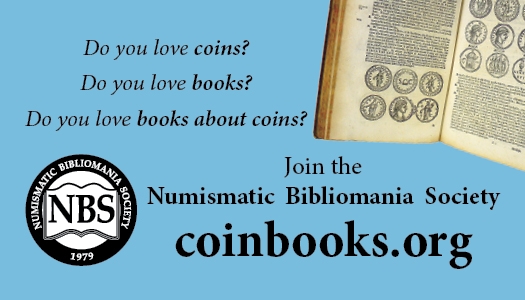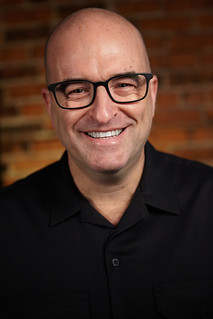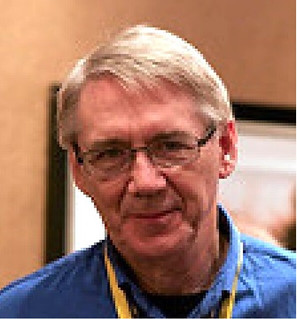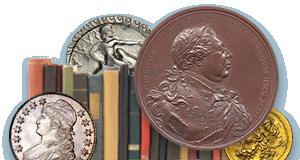
Visit our NBS Sponsors
About UsThe Numismatic Bibliomania Society is a non-profit association devoted to the study and enjoyment of numismatic literature. For more information please see our web site at coinbooks.org SubscriptionsThose wishing to become new E-Sylum subscribers (or wishing to Unsubscribe) can go to the following web page link MembershipThere is a membership application available on the web site Membership Application To join, print the application and return it with your check to the address printed on the application. Print/Digital membership is $40 to addresses in the U.S., and $60 elsewhere. A digital-only membership is available for $25. For those without web access, write to: Jeff Dickerson, Treasurer AsylumFor Asylum mailing address changes and other membership questions, contact Jeff at this email address: treasurer@coinbooks.org SubmissionsTo submit items for publication in The E-Sylum, write to the Editor at this address: whomren@gmail.com BUY THE BOOK BEFORE THE COINSale CalendarWatch here for updates! |
- WAYNE'S WORDS: THE E-SYLUM FEBRUARY 9, 2025
- NEW BOOK: CATALOGUE OF KOTALINGALA COINS
- THE E-GOBRECHT JANUARY 2025
- THE TAMS JOURNAL JAN-FEB 2025
- SUPER BOWL TOSS COINS & MEDALS
- VIDEO: COLLECTING OUTSIDE YOUR BOX
- THE PROPOSED ROYAL ACADEMY MEDAL OF 1793
- ERROR COINS THAT ‘ESCAPED THE MINT'
- NOTES FROM E-SYLUM READERS: FEBRUARY 9, 2025
- STACK'S BOWERS ACQUIRED BY A-MARK
- MORE ON A-MARK STACK'S BOWERS ACQUISITION
- SOME A-MARK COMPANY HISTORY
- STACK'S BOWERS PROFESSIONAL NUMISMATIST PROGRAM
- 2025 ANA CLUB PUBLICATIONS COMPETITION
- VOCABULARY TERM: REFLECTIVENESS
- MORE ON ALAN KESSLER
- EXHIBIT HONORS EGYPT'S PIONEER NUMISMATIST
- NUMISMAGRAM MEDAL SELECTIONS: FEBRUARY 9, 2025
- HERITAGE: ENCASED POSTAGE STAMPS
- MORE ON NUMISMATIC AUCTIONS LLC SALE 69
- HERITAGE: CONTINENTAL CURRENCY SIGNERS
- COINS OF THE FOURTH CRUSADE
- "DEVIL'S MONEY" CULT RITUALS
- COLLECTABLE COUNTERFEIT COINS, PART THREE
- COLONIAL GEORGIA COLORED SEALS, PART 1
- 1870 DOMINION OF CANADA $2 BANKNOTE
- LEGAL WIN FOR TOMMY THOMPSON
- THE 2025 CRYSTAL BALL
- LOOSE CHANGE: FEBRUARY 9, 2025
- ABOUT THIS ISSUE: FEBRUARY 9, 2025
Content presented in The E-Sylum is not necessarily researched or independently fact-checked, and views expressed do not necessarily represent those of the Numismatic Bibliomania Society.
WAYNE'S WORDS: THE E-SYLUM FEBRUARY 9, 2025
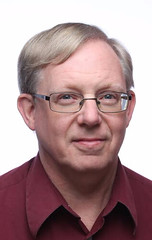 New subscribers this week include:
Alan Harlan.
Welcome aboard! We now have 7,255 subscribers.
New subscribers this week include:
Alan Harlan.
Welcome aboard! We now have 7,255 subscribers.
Thank you for reading The E-Sylum. If you enjoy it, please send me the email addresses of friends you think may enjoy it as well and I'll send them a subscription. Contact me at whomren@gmail.com anytime regarding your subscription, or questions, comments or suggestions about our content.
This week we open with one new book, two periodical issues, updates from the Newman Numismatic Portal, error coins, notes from readers, and more.
Other topics this week include the 1793 Royal Academy medal design, a major acquisition in the numismatic world, the ANA's Club Publications competition, reflectiveness, author Alan Kessler, fixed price and auction selections, encased postage stamps, Continental Currency, Devil's Money, colonial Georgia colored seal notes, and predictions for 2025.
To learn more about the Kotalingala coins of India, "Double Dimes", Daguerreian tokens, Super Bowl Toss coins and medals, the San Francisco Mint oil pan errors, the Thursday Lunch Club, Steve Markoff and A-Mark Financial Corporation, the Kwajalein Missile Range, Dr Abdel Mohsen El-Khachab, postage stamp envelopes, and the perpetual coin show, read on. Have a great week, everyone!
Wayne Homren
Editor, The E-Sylum
NEW BOOK: CATALOGUE OF KOTALINGALA COINS
A new book has been published on the Kotalingala coins of India. -Editor
About The Book
 Kotalingala is an early historic site lying on the banks of River Godavari in the Karimnagar district of Telangana. The discovery of coins from Kotalingala in 1978 is considered as an important event in south Indian numismatics. Staggering variety of coins were found in the surface as well as in excavations conducted at this site. The coins included punch marked, uninscribed and inscribed coins. Punch marked coins belonged to Nanda and Maurya dynasties. Uninscribed coins belonged to local rulers. Inscribed coins belonged to both Pre-Satavahana local rulers namely Gobhada, Narana, Kamvayasa, Sirivayasa and Samagopa and early Satavahana kings Chimuka and Satakani etc. Chimuka was the founder of the Satavahana dynasty. There were also coins of the satraps or officials of that era. The book lists the coins found at Kotalingala and analyses their contribution to the history of Satavahana dynasty.
Kotalingala is an early historic site lying on the banks of River Godavari in the Karimnagar district of Telangana. The discovery of coins from Kotalingala in 1978 is considered as an important event in south Indian numismatics. Staggering variety of coins were found in the surface as well as in excavations conducted at this site. The coins included punch marked, uninscribed and inscribed coins. Punch marked coins belonged to Nanda and Maurya dynasties. Uninscribed coins belonged to local rulers. Inscribed coins belonged to both Pre-Satavahana local rulers namely Gobhada, Narana, Kamvayasa, Sirivayasa and Samagopa and early Satavahana kings Chimuka and Satakani etc. Chimuka was the founder of the Satavahana dynasty. There were also coins of the satraps or officials of that era. The book lists the coins found at Kotalingala and analyses their contribution to the history of Satavahana dynasty.
Preface
The village named Kotalingala lying on the right bank of River Godavari in the Karimnagar district of Telangana first came to light in 1978 when a postal officer of the village named S. Narahari brought 100 copper coins which were collected by the villagers from mounds during agricultural operations (Parabrahma Sastry 1978 a). The village proper and its adjoining high mounds cover an area of about 100 acres, along the riverbank. A study of the coins from Kotalingala by Parabrahma Sastry (1978 b) revealed that all the coins were new, previously unknown in the history of Indian numismatics. These coins belonged to the early rulers of the Satavahanas and their predecessors such as Chimuka Satavahana, Gobhada, Samagopa, Satakarni etc. Gupta (1978) noted the significant discovery of the coins from Kotalingala and called it an outstanding event in the realm of Indian numismatic studies.
Realising the significance of the discovery of these coins, Archaelogy department undertook the excavation of the site during the years 1979-1983 (Annual reports of the archaelogy department 1980-1981 and 1981-1982). The department also purchased 140 Kotalingala coins from Narahari on 27- 11-1978 (Annual report of the archaeology department 1978-1979). Except for a brief report about the excavations in the annual reports of the archaeology department of the Government of Andhra Pradesh and description some of these coins by Parabrahma Sastry, a detailed report of the coins found on the surface and in excavations was never compiled except for a report by Ramachandra Murthy (2006). Hence this catalogue of the coins from Kotalingala are being published which excluded very worn out and encrustrated coins.
Introduction
Satavahana was the first major dynasty to rule from Dakshinapath or Deccan in ancient India and Kotalingala on the banks of River Godavari in Karimnagar district of Telangana is acknowledged as its first capital. The coins were found in the surface as well as in the excavations conducted at the site between 1979 and 1983 AD.A total of 430 coins were found and out of these 157 were surface finds and 273 were found in trenches from excavations. In addition the archaeological department purchased 140 coins from Narahari through a committee on 9-1-1979.A hoard of 400 punch marked coins were found as a hoard during the first year of excavations.
To summarize a staggering variety of coins were found at Kotalingala that included un-inscribed and inscribed issues. Un-inscribed coins belonged imperial type of punch marked coins of Nanda and Maurya dynasties and un-inscribed cast coins of local rulers.Majority of inscribed coins were those of Pre- Satavahana local rulers and early kings of Satavahana dynasty. Besides coins of satraps such as Mahatalavara, Maharathi, Mahasenapati and Sebaka were also found at Kotalingala. There were also few coins of later Satavahana rulers discovered at this site establishing the fact that this region was always under the Satavahana rule. The archaeological department brought out a report on excavations conducted at Kotalingala during the years 1979-1983 and the report contained a general description of 137 without illustrations of the coins. Surprisingly the report contained description of 20 punch marked coins though 421 were found during investigation.
About the Author
Deme Raja Reddy, is a well- known neurosurgeon and a numismatist. Reddy headed the departments of neurosurgery at Osmania medical college, Gandhi medical college and Nizam's institute of medical sciences in Hyderabad. With his medical background he brought in scientific and analytical approach to the study of ancient Indian coins. Reddy is an authority on coins of the Deccan and published more than twenty books on the subject. He wrote more than 100 articles on ancient coins in national and international journals. He was the past president of the south Indian numismatic society of Chennai and that of the numismatic society of India of Varanasi. He was also the past editor of the two journals published by these societies. He was the past president of the Telangana history congress and the president of ancient section of the Andhra Pradesh history congress. He was the recipient of Marremanda Rama Rao medal of the numismatic society of India and P.L. Gupta medal of the south Indian numismatic society.
Presently he is the chairman of the numismatic society of India.
Publisher: B.R. Publishing Corporation
Language: English
Edition: 2024
ISBN: 9788119808281
Pages: 224 (Throughout Color Illustrations)
Cover: HARDCOVER
9.5x6.5 inch
596 gm
Found via the Winter 2024 issue of the Journal of the Oriental Numismatic Society. -Editor
For more information, or to order, see:
A Catalogue of Kotalingala Coins
(https://www.exoticindiaart.com/book/details/catalogue-of-kotalingala-coins-hac509/)
THE E-GOBRECHT JANUARY 2025
the January 2025 issue of the E-Gobrecht from the Liberty Seated Collectors Club has been published. -Editor
Contents
-
 President's Message by Len Augsburger
President's Message by Len Augsburger
- Editor's Viewpoint: View From The Rim by Paul Kluth
- Club Announcements / Membership Application
- 2024 – COIN YEAR IN REVIEW by Rich Uhrich Jr.
- The Curious Collector: The 2025 Crystal Ball Speaks by Len Augsburger
- 2025 Precious Metals Forecast by Jeff Pritchard
- Here's to a Big Shout Out for the LSCC by Tom Uram
- The Latest News on Liberty Seated Half Dimes by Clint Cummins and Alan Welty
- The Gerry Fortin Liberty Seated Dime Collection Sale – Thoughts as the Sale Date Approaches by Gerry Fortin
- Double Dimes – A Look Back, and a Look Forward to 2025 by John Frost
- Liberty Seated Quarter Collecting in 2024 / 2025 by Greg Johnson
-
 2024 Liberty Seated Half Dollar Year-End Report
by Bill Bugert and Dennis Fortier
2024 Liberty Seated Half Dollar Year-End Report
by Bill Bugert and Dennis Fortier
- 2024 – The Year in Review - L.S. Dollars by Dick Osburn
- Update on Reeded Edge Half Dollars by Jim Koenings
- The ANS Attends Historic Commemoration of Christian Gobrecht by Jesse Kraft
- Regional News: The Winter/Spring Regional LSCC Program Kicked Off at FUN by Ken Otto
- PRESS RELEASES - Gerry Fortin Collection & EPNNES Grant
- Club News Bulletins: New LSCC Website Goes Live & ANA Summer Seminar 2025 - New Class Offered
Editor Paul Kluth writes:
"Besides this being our 21st year of publication for subscribers (we are almost at our next milestone of 1500 complimentary subscriptions by the LSCC), this issue features great commentary on the past year of 2024 and an Outlook (forecast or prediction if you will) for 2025 related to Liberty Seated collecting and numismatics in general. In fact there is something from both Tom Uram (ANA) and Jesse Kraft (NBS), and Rich Uhrich has returned after several years (well respected, retired dealer) with his popular "Year in Review".
"Personally, I was shocked to receive Len Augsburger's column this month in that is quite hilarious and worth sharing with the numismatic world. I didn't know Len had it in him. I told him it was really brilliant!"
See an article elsewhere in this issue where we republish Len's prognostications.
Two things that caught my eye in this issue were images of trays of engraved and counterstamped "Double Dimes" (Twenty Cent Pieces) from the reference collection of Lane Bruner. Note that several are stamped with the number "20" to visually distinguish them from 25-cent pieces. -Editor
For more information about the Liberty Seated Collectors Club, see:
https://lsccweb.org/
THE TAMS JOURNAL JAN-FEB 2025
The January-February 2025 issue of The TAMS Journal has been published. -Garrett
 The TAMS Journal
The TAMS Journal
V65, N1 January-February 2025
ARTICLES
Tin Cans and Tokens: A Numismatic History of the Oyster Industry in America
David E. Schenkman and Eric R. Schena
Selling Likeness: An Introduction to Daguerreian or Photographic Tokens (1850-1890)
Jorge L. Crespo-Armáiz, PhD
Terrace Garden, San Francisco
Michael Wehner
Maverick Transportation Tokens Identified
David E. Schenkman
COLUMNS
 From the President
From the President
James Brokamp
Sixty Years Ago in TAMS
Greg Burns
So-Called Dollar Stories
Je? Shevlin
Counterstamp Corner
Greg Bennick
This & That
Harry Waterson
American Token Manufacturers & Their Agents
David E. Schenkman
SOCIETY NEWS AND REPORTS
Secretary's Report
Donna Moon
General News/Pleas
Farewells
Letters
Here's an excerpt from editor Greg Burns' intro to the issue. -Editor
Fingers on the Keyboard
 I'm writing this on
Christmas Eve, and happy to be looking forward
to wrapping up 2024
shortly. It's been a good
year (aren't they all?),
but a busy one.
I'm writing this on
Christmas Eve, and happy to be looking forward
to wrapping up 2024
shortly. It's been a good
year (aren't they all?),
but a busy one.
Over the past year we've added columnists, maintained a good backlog of upcoming articles written by skilled writers on engaging topics (we can always use more), and enjoyed a well-printed journal for our society with which to stock our numismatic libraries (thanks to Minuteman Press of Toledo for that!), and done so when many similar specialty groups and publications are struggling. While I very much hope we can continue this path, it would be a wonderful dream-come-true if we were able to grow our membership and expand TAMSJ. Eh, something to think about for 2025.
Maybe you can do something to help. We always need new members (get the word out), and welcome new volunteers within the TAMS administrative body. You've seen new names during this past year as well on the masthead just inside the front cover. It could list your name there, you know.
This issue contains Ryan Kordziel's inaugural oversight of the "Mavericks" column, and he soon hopes to be able to give the green light on new submittals for attribution. In the meantime, there are a lot of unattributed pieces still needing information, so feel free to fritter away some cold winter hours delving into investigation resources.
In closing, I'm optimistic for the coming year and hope all our readers have a great 2025 in store for them. Lots of great acquisitions (or sales), fun researching the little pieces that capture our imaginations, and great times with our fellow collectors!
TAMS is a great organization with a top-notch periodical. If you've never been a member, or your membership has lapsed, now's a great time to sign up. -Editor
For more information, see:
https://www.tokenandmedal.org/
SUPER BOWL TOSS COINS & MEDALS
Newman Numismatic Portal Project Coordinator Len Augsburger provided the following report on Super Bowl toss coins & medals. Thanks. -Editor
Super Bowl Toss Coins & Medals
 With the Super Bowl being the most watched event on the American sports calendar, it's no surprise that connections to nearly all walks of life, including numismatics, come to the fore. Super Bowl medals were apparently first produced by MintAmerica in North Miami, Florida, beginning in 1973. A Coin World ad (August 22, 1973) notes "the National Football League for the first time has authorized the Official Super Bowl Medals….." These pieces were 50mm silver proofs.
With the Super Bowl being the most watched event on the American sports calendar, it's no surprise that connections to nearly all walks of life, including numismatics, come to the fore. Super Bowl medals were apparently first produced by MintAmerica in North Miami, Florida, beginning in 1973. A Coin World ad (August 22, 1973) notes "the National Football League for the first time has authorized the Official Super Bowl Medals….." These pieces were 50mm silver proofs.
Coin World reported on February 7, 1973, that a Franklin Mint-produced piece featuring Vince Lombardi was used as the toss coin for Super Bowl VII. The February 14, 1979 edition of Coin World noted that Chicago Bears owner George Halas donated a 1920 double eagle (commemorating the birth year of the NFL) as the Super Bowl toss coin. Halas announced the loser of the toss would receive the coin, which went to the Pittsburgh Steelers' Jack Lambert following the toss ceremony. The Steelers ended up winning both the game and the coin.
The toss coin is currently manufactured by the Highland Mint in Melbourne, Florida. Ten thousand examples are produced, with coin #1 being used for the opening coin toss and coin #0 in case of overtime. The Highland Mint has been producing the Super Bowl coins since the mid-1990s. The Danbury Mint in Norwalk, Connecticut also sells officially licensed Super Bowl "flip coins," which are marketed as "commemoratives." A set of 50 such pieces is currently listed on eBay, by a secondary seller, at $800.
Link to Super Bowl XIII coin toss video:
https://www.youtube.com/watch?v=y9ceVwCdLU0#t=5m53s
Link to New York Times coverage of the Super Bowl XIII coin toss:
https://www.nytimes.com/athletic/6100532/2025/02/03/super-bowl-coin-toss-bet-odds/
Link to CBS coverage of the Highland Mint:
https://www.cbsnews.com/miami/news/coin-that-kicks-off-super-bowl-is-made-in-florida/
Link to "Super Bowl" search results on Newman Portal:
https://nnp.wustl.edu/library/searchwithterms?searchterm=Super%20bowl
VIDEO: COLLECTING OUTSIDE YOUR BOX
The David Lisot Video Library on the Newman Numismatic Portal can be found at:
https://nnp.wustl.edu/library/multimediadetail/522852
We highlight one of his videos each week in The E-Sylum. Here's one from the 2009 ANA convention with Larry Gaye and Jerry Bobbe speaking about "Collecting Outside Your Box". -Editor
Advice on how to seamlessly move from your collecting area of specialty to other subjects you can learn about and enjoy. You never know where numismatics can take you, but the journey sure is fun!
Speaker(s): Larry Gaye & Jerry Bobbe. From the 2009 ANA convention.
To watch the complete video, see:
Collecting Outside Your Box
(https://youtu.be/IOnl0wJ7e6A)
Collecting Outside Your Box
(https://nnp.wustl.edu/library/book/557313)
THE PROPOSED ROYAL ACADEMY MEDAL OF 1793
The Benjamin West letter last week inspired this note from Zach Filis. Thank you! -Editor
This doesn't really answer your question about Sir Stephen Contrell, it is about medals and not coin designs.
From the British Numismatic Society, Laurence Brown's book on British Historic Medals, Ashmolean Museum and my collection.
The twenty-fifth anniversary of the Royal Academy fell on 10 December 1793, and a general meeting was called a week later to reach final agreement on the manner of celebration. It was Farington himself who put the formal proposals to the meeting, namely that they should hold a special Academy dinner; present a loyal address to their patron, King George Ill; and make arrangements to have a medal struck - proposals which were unanimously agreed.
Benjamin West, the Academy president, wasted no time in the matter of the medal design, for within a fortnight of the original meeting he invited Farington to call. 'He showed me', Farington wrote on 30 December 1793, 'a design he had made for the medal. On one side the King's head, on the other Painting, Sculpture and Architecture, represented by three Figures' There is no difficulty in recognizing this as the drawing now preserved in the Ashmolean Museum.
The fact that no trace of the medal has emerged is to my mind conclusive proof of its non-existence.
Many proofs can be found of West's recurrent interest in medals, and in 1815 he took the unusual step of commissioning a medal of himself (Brown 862).
Regarding the coin design letter, Zach adds:
"I believe that there is much research that can be accomplished on this matter both within the United States and England. The records are not easily accessed, however.
"I would like to know where the writer obtained the information on Cottrell. I believe that there is more information regarding Cottrell that can be found in the archives."
To read the earlier E-Sylum article, see:
BENJAMIN WEST BRITISH COIN LETTER OFFERED
(https://www.coinbooks.org/v28/esylum_v28n05a02.html)
ERROR COINS THAT ‘ESCAPED THE MINT'
Scott Sery writes:
"A recent article in the E-Sylum involving stolen coins got me thinking again (this could be dangerous Ha !). I've always thought modern proof error coins should be considered government property which means that these were not only recently stolen, they were likely stolen from the Mint in 1972. Nothing against error coin dealers or collectors, just some thoughts of mine."
Well, that's of course a possibility, but difficult to prove. These have been out in the market for some time.
For more information I reached out to error dealer Mike Byers (from whom these pieces were stolen). Here's his summary. Thank you! -Editor
There are five groups of U.S. proof error coins that ‘escaped the Mint'. Below I give three examples with brief descriptions. The most famous hoard is the group that was auctioned by the State of California, after being examined by the U.S. Secret Service.
1. The SF oil pan hoard- in the 70's the forklifts that were used inside the Mint were serviced outside of the Mint. Employees would place proof error coins in the oil pans.
2. John Devine's (Lonesome John) hoard- John had many proof error coins from the SF Mint, including an Ike Dollar in proof, struck on 3 nickel blanks. I purchased this clover leaf and sold it to Dr. Berry.
Dr. Berry assembled the finest Ike Dollar error collection in the 70's and eventually donated it to the ANA.
3. The SF safety deposit box hoard- the most famous hoard known of U.S. proof error coins that escaped the Mint. A group of San Francisco Proof Errors were discovered in a safety deposit box. They were unclaimed and subsequently auctioned by the State of California, after being examined by the U.S. Secret Service, after determining that they were legal to own.
4. A 50 year raw collection that surfaced around 2015.
5. Another 50 year raw collection surfacing around 2020.
Below are three links to a U.S. proof error coin from one of these groups mentioned above:
This mated pair was recently authenticated and certified by NGC and is from a 50 year old U.S. proof mint error collection that recently surfaced. This mated pair belongs in an Eisenhower Dollar collection or a collection of major mint errors:
https://mikebyers.com/6329750-003-004.html
This deliberately struck unique and exotic Bicentennial Quarter error is in gem condition with amazing eye appeal. It is pedigreed to John Devine "Lonesome John," a famous pioneer in the field of mint errors and was just certified by NGC. It was previously unknown to the numismatic community and is just now being offered for sale:
https://mikebyers.com/6606002-001.html
This unique 1970-S Proof Quarter from the United States was overstruck on a 1941 Quarter from Canada and was intentionally produced. This mint error was originally discovered in the group of San Francisco Proof Errors that was auctioned by the State of California, after being examined by the U.S. Secret Service. There is a significant amount of detail on both sides showing the design of the Canadian Quarter. This is one of the most fascinating and intriguing proof mint errors ever discovered:
https://mikebyers.com/45587309.html
To read the earlier E-Sylum article, see:
NOTES FROM E-SYLUM READERS: FEBRUARY 2, 2025 : Error Coins Stolen
(https://www.coinbooks.org/v28/esylum_v28n05a12.html)
NOTES FROM E-SYLUM READERS: FEBRUARY 9, 2025
Counting on Girl Scouts Daisy Dollars
Susan Sims writes:
"I just read the E-Sylum and, as usual, found several interesting articles. The article by George Cuhaj was quite fun. I am so happy the Girl Scouts are doing this. What a fun way to learn about money and counting change. Thanks for the great issue."
Numismatics is everywhere, even in Girl Scout cookies and the Super Bowl. -Editor
To read the earlier E-Sylum article, see:
GIRL SCOUTS USA DAISY DOLLARS
(https://www.coinbooks.org/v28/esylum_v28n05a15.html)
1879 Indian Cent Find
Gerry Tebben writes:
"The oldest coin I ever found was an 1879 Indian cent that I found in a roll in 1960. I traded it for a much more desirable 1955-S Lincoln cent, the last coin I needed to fill Book 2. I was 10.
"I took it to a long-gone shop that was up a flight of stairs in Butler, Pa. (The store also had plastic models that were probably more interesting to me than coins). With a Red Book in hand, I figured I could trade my Indian for several Lincolns and trade the extras with my friends. The dealer thought otherwise. One for one. Profit, he explained. Still, I was happy. I got to complete my book. I remember thumbing the uncirculated coin into the hole. Nothing else would do.
"If you were a kid in 1960, the 1955-S was the rarest coin there ever was. We were all looking for one. We all needed one to fill the last hole. And no one I knew ever found one.
"While it may not have been the smartest move I ever made financially. I was happy then and I'm happy now. Completing that set and competing with my friends was more important than money."
Great memory. -Editor
To read the earlier E-Sylum article, see:
OLDEST COINS FOUND IN CHANGE
(https://www.coinbooks.org/v28/esylum_v28n05a11.html)
More on the "Wedding Coins"
Joel Anderson writes:
Over the years I have offered tokens similar to Ted's Token in my catalogs. My suppliers from Asia described them "wedding coins". The items I had were modern creations, supposedly based on older pieces.
In 1990 I described them as follows (unfortunately I cannot find the image)
CHINESE WEDDING COINS
These cash-style (round with square hole) tokens were traditionally given
to Chinese brides for their wedding. The front reads "How to please a man" (in Chinese) and the back shows how in graphic detail. These are modern versions of the traditional "wedding coin".
MED-CW? CHINESE WEDDING COIN .................................... $4.00
From 2004 to 2007 I offered the following "Chinese wedding coins" on my website:
 According to tradition, Chinese brides would be given these "coins" or charms on their wedding night so they would know what to do. We offer modern versions of the Chinese Wedding Coin in two sizes, 39mm and 27mm. Both are quite crudely made and are struck in a copper alloy. They have four sets figures around the square hole on one side, and Chinese characters on the other.
According to tradition, Chinese brides would be given these "coins" or charms on their wedding night so they would know what to do. We offer modern versions of the Chinese Wedding Coin in two sizes, 39mm and 27mm. Both are quite crudely made and are struck in a copper alloy. They have four sets figures around the square hole on one side, and Chinese characters on the other.
Item N-CN-WEDLG LARGE CHINESE WEDDING COIN, (approx 39mm) crude $9.75
Item N-CN-WEDSM SMALL CHINESE WEDDING COIN, (approx. 27mm) crude $7.50
Joel also found a useful Wikipedia article on these. Thanks! -Editor
To read the complete article, see:
Marriage coin charm
(https://en.wikipedia.org/wiki/Marriage_coin_charm)
To read the earlier E-Sylum articles, see:
WEDDING TOKEN OR BROTHEL TOKEN?
(https://www.coinbooks.org/v28/esylum_v28n04a13.html)
NOTES FROM E-SYLUM READERS: FEBRUARY 2, 2025 :
Brass Checks book coverMore on Brass Checks and Red Lights
(https://www.coinbooks.org/v28/esylum_v28n05a12.html)
1977 Zurich Show Photo
Jeffrey Zarit writes:
"This was sent to me by a German Colleague and Friend. The caption at the bottom (hard to see) says that this is: me, Richard Margolis, Tom Hamilton with his hand on his head, and two others I do not know. It was taken at the 1977 International Hotel Bar in Zurich. All of us have boxes in front of us looking at coins. They used to have a show there every fall, and much business was done prior to the show itself. In today's age, I just cannot imagine something like this happening today. It is too bad, as relationships were built on such interactions."
Great picture - thanks for sharing this. Can anyone identify others in the photo? -Editor
Thursday Lunch Club, Friday Edition
Here's a more contemporary numismatic gathering of colonial collectors, in New Jersey. -Editor
Ray Williams writes:
"Friday was the gathering of our Thursday Lunch Club. The date was changed so that one of us could make the 2 1/2 hour drive to attend. We discussed possibilities for a name change but didn't decide yet. Our first lunch group was over 20 years ago and consisted of four of us: Syd Martin, Roger Siboni, Leo Shane and myself. Roger Moore joined us a short time later.
"Eight of us were able to attend yesterday at the Town & Country Diner in Bordentown. In the picture clockwise from the left are: Matt Virga, Leo Shane, Mike Brooks, Dan Knight, Bill Liatys, Ray Williams, John Louis and Wayne Shelby. Two couldn't attend for personal reasons and we're hoping a snow bird will join us again when the weather warms and he travels north from Florida.
"The Diner has an excellent menu with many many choices. Also, it's large enough so that we can spend all the time we want at our table.
"Our show n tell adds to the excellent hobby discussions. Some of the items brought were silver shillings of the 1700s, Maris 14-J and 51-g, Vlack 5-72A and 14-84A. Continental Currency notes and also beautiful examples of notes from South Carolina & Georgia. A beautiful Pitt Token and Voci Populis (2). There were a number of Magic Lantern cards, all having themes about George Washington. There was a beautiful 1771 British 1/2d with some rim damage and a Lion Half Dollar with two dates (unique?). A Maris 77-dd double struck with the date reading 17888. And much more. The only thing better than colonial collectors getting together with some coins, is doing it over food!
"Looking forward to our next lunch."
STACK'S BOWERS ACQUIRED BY A-MARK
On February 3, 2025, Stack's Bowers Galleries published an email announcement of their acquisition by A-Mark Precious Metals, Inc. -Editor
Dear Friends,
We are excited to share an important milestone in the history of Stack's Bowers Galleries. We have entered into a definitive merger agreement to be acquired by A-Mark Precious Metals. Under this agreement, Stack's Bowers Galleries will continue to operate as a standalone, independently operated, wholly-owned subsidiary of A-Mark, a Nasdaq-listed company. We will join A-Mark's portfolio of industry-leading brands, including JM Bullion, Goldline, LPM Group, and Collateral Finance Corporation (CFC).
For nearly a century, Stack's Bowers Galleries has been recognized as a leading numismatic auctioneer, entrusted with the sale of some of the most historically significant and valuable rarities and collections, as well as tens of thousands of more modestly priced numismatic collectibles. In addition to our renowned auctions, we are also a premier wholesale and retail dealership, supplying rare coins, currency, and precious metals to other retailers as well as directly to collectors. This merger with A-Mark will provide us with the resources and scale to accelerate our growth and enhance the services we offer to our valued clients.
By leveraging A-Mark's financial strength and industry expertise, we will be better positioned to continue to expand our auction and dealership businesses. We expect this partnership to enable us to invest in new and existing services, pursue strategic geographic expansion, and capitalize on opportunities for acquiring complementary businesses and advanced technologies. Additionally, access to A-Mark's secured lending solutions through its Collateral Finance Corporation will provide enhanced financing options for consignors and bidders. The cross-promotion of our auction and retail listings to A-Mark's more than 3 million direct-to-consumer customers presents a significant opportunity for growth and added value for our auction consignors.
Going forward, our leadership team will remain in place, ensuring that Stack's Bowers Galleries continues to operate seamlessly with the same dedicated numismatists and employees you have come to know and trust. Your experience with Stack's Bowers Galleries will remain uninterrupted, and we look forward to serving you with even greater capabilities.
To learn more about this transaction, click here to read the official press release.
Sincerely,
Greg Roberts, CEO
Brian Kendrella, President
Andrew Glassman, CFO
The business landscape of numismatics is always changing, and in recent years companies have gotten bigger and bigger through acquisitions large and small. As a longtime collector I've gotten used to the constancy of change as companies and alliances form and split, and businesses are taken public and private again and again. I'm glad to hear the familiar Stack's Bowers brand will continue on, and look forward to seeing familiar SBG faces at this year's shows, along with their planned and future auction sales. A-Mark is a familiar name, tracing its history back to 1965. -Editor
MORE ON A-MARK STACK'S BOWERS ACQUISITION
Here's an excerpt of the A-Mark press release with more detail on the acquisition of Stack's Bowers Galleries. -Editor
A-Mark Precious Metals, Inc., a leading fully integrated precious metals platform, has entered into a definitive agreement to acquire 100% of the stock of Spectrum Group International, Inc. (SGI), the parent of Stack's Bowers Galleries (SBG), one of the world's largest rare coin and currency auction houses and a leading wholesale and retail dealer specializing in numismatic and bullion products, and the majority owner of Spectrum Wine (SW), a global auctioneer, retailer and storage provider of fine and rare wine.
The transaction is intended to complement A-Mark's core bullion business by, among other benefits, increasing its reach into strategically adjacent luxury markets that are expected to offer higher margins and expanded customer bases.
A-Mark will pay $92 million to acquire 100% of SGI's outstanding stock. The consideration will be comprised of 50% cash and 50% A-Mark common stock, with the stock portion valued as of the signing of the definitive agreement. The acquisition is expected to close within 30 days, subject to certain closing conditions, including the approval of SGI's shareholders, the execution of financing arrangements and the consent of A-Mark's lenders.
Spectrum Group International Overview
A-Mark has a long-standing relationship with SGI. A predecessor entity of SGI acquired 80% of A-Mark in 2005 and the balance of the Company in 2011. A-Mark was then spun-off into a separate publicly traded company in 2014. Greg Roberts is the Chief Executive Officer of both A-Mark and SGI, Mr. Roberts and another A-Mark executive comprise a majority of the board of SGI, and several A-Mark board members are shareholders of SGI. A-Mark established a special committee of independent members of its board to negotiate the acquisition on the Company's behalf and to recommend approval of the acquisition.
Stack's Bowers Galleries
SBG was founded in 1933 in New York and has grown to become a global leader in numismatics and bullion operating in two complementary units. The Auction Services unit conducts in-person, internet and specialized auctions of consigned and owned items and has sold a wide range of the most important rarities and numismatic collections over its distinguished history. SBG's Dealership unit maintains a sizeable inventory of rare coins and paper money that it sells as both a wholesaler to other retailers and a Direct-to-Consumer dealer. It also maintains a meaningful bullion inventory and is an important A-Mark trading partner. In addition, SBG complements A-Mark's distribution network in that it works with smaller institutional as well as retail customers. SBG is headquartered in Costa Mesa, California and operates additional offices in the United States, Europe and Asia.
Management Commentary
"Acquiring SGI is a strategic step that significantly enhances A-Mark's position in high-value collectibles," said A-Mark CEO Greg Roberts. "By integrating Stack's Bowers Galleries' expertise in rare coins and paper currency, we are expanding into a bullion-adjacent category that commands higher premiums and stronger margins while also broadening our customer base. Spectrum Wine's focus on premium wines introduces a new revenue stream that complements our business model including Direct-to-Consumer expertise.
"This transaction also creates meaningful cross-selling opportunities as significant synergies exist between A-Mark's Direct-to-Consumer and wholesale customers and SGI's collectors, investors, and dealers. Having led SGI for many years, I am optimistic this acquisition will be financially and strategically accretive to A-Mark."
Brian Kendrella, President of SBG, added: "Joining forces with A-Mark allows us to leverage its financial strength and operational scale to accelerate growth in our auction, wholesale and retail businesses. Access to A-Mark's lending solutions offered by its Collateral Finance Corporation secured lending subsidiary will provide enhanced financing options for consignors and bidders, and cross promotion of our auction and retail listings to A-Mark's Direct-to-Consumer customers is expected to provide a significant opportunity for growth and added value to our auction consignors."
To read the complete press release, see:
A-Mark Expands Product Portfolio into Collectibles by Acquiring the Parent of Stack's Bowers Galleries
(https://www.greysheet.com/news/story/a-mark-expands-product-portfolio-into-collectibles-by-acquiring-the-parent-of-stacks-bowers-galleries)
SOME A-MARK COMPANY HISTORY
Here are some bits of information on the history of A-Mark for those who may not be familiar with the firm. Many thanks to Len Augsburger of the Newman Numismatic Portal for assistance. Len notes that the earliest mention in Coin World is a July 8, 1964 want ad by what was then called the A-Mark Coin Company. -Editor
The business was founded by Steven C. Markoff. Here's an encyclopedia.com excerpt. Shown is a full-page ad in the August 23, 1967 Coin World promoting silver investments. -Editor
 Steven C. Markoff laid the groundwork for A-Mark Financial Corporation when he was yet a teenager, according to the Los Angeles Business Journal. A coin collector, Markoff established A-Mark Coin Company in 1965 and entered the rare coins and precious metals trading business. In 1972, the U.S. Treasury granted A-Mark a special license for dealing in gold. When gold ownership was extended as a right to all U.S. citizens in 1974, the company seized the opportunity to expand its business.
Steven C. Markoff laid the groundwork for A-Mark Financial Corporation when he was yet a teenager, according to the Los Angeles Business Journal. A coin collector, Markoff established A-Mark Coin Company in 1965 and entered the rare coins and precious metals trading business. In 1972, the U.S. Treasury granted A-Mark a special license for dealing in gold. When gold ownership was extended as a right to all U.S. citizens in 1974, the company seized the opportunity to expand its business.
Four years later came another boon: The price of silver skyrocketed. The metal became very precious at $50 an ounce. Family heirlooms and coin collections were melted down to take advantage of the 1980 price surge, the Houston Chronicle recounted. During the year A-Mark traded millions of ounces of silver. In 1981, the company minted its first proprietary one-ounce silver bar.
A-Mark Precious Metals, Inc. sales topped $1 billion for 1983. The following year, the company began encapsulating and certifying gold coins through its Guaranteed U.S. Gold program.
By 1990, A-Mark was one of the largest wholesalers of precious metals, with banks, brokerage houses, refiners, jewelers, investment advisors, coin dealers, and government mints its main clients. The company had evolved along with the industry, growing as the market grew. "Since I've gotten into it, it's gone from a cottage industry to a fairly established market with very large players," Markoff told the Los Angeles Business Journal.
To read the complete article, see:
A-Mark Financial Corporation
(https://www.encyclopedia.com/books/politics-and-business-magazines/mark-financial-corporation)
The company also owned Superior Stamp & Coin. Here's a Wikipedia excerpt. -Editor
Steven Markoff is a native of Los Angeles. He graduated from Los Angeles City College in 1964. In 1965, Markoff founded the A-Mark Financial Corporation, a Santa Monica-based financial services company that trades in rare coins and precious metals. The company was originally known as the A-Mark Coin Company (and later A-Mark Precious Metals, Inc.). A-Mark initially operated primarily as a wholesaler of rare coins and gold and silver bullion. In addition to serving as chairman and CEO of A-Mark, Markoff also held the role of president of the American Coin Exchange in the 1970s.
In January 1976, Markoff (through A-Mark) purchased The Redfield Hoard silver dollar collection for $7.3 million. The collection consisted of over 407,000 silver dollar coins weighing a total of 12 tons. Later that year, Markoff facilitated A-Mark's purchase of the J.E. Wilkinson gold pattern coin collection, consisting of 45 coins valued at a total $5 million. The collection also featured the 1907 Indian Head Double Eagle pattern worth $1 million on its own. The coin was formerly owned by King Farouk of Egypt.
Markoff saw continued success through A-Mark with sales exceeding $1 billion annually in the 1980s and 90s. In 2000, the Los Angeles Business Journal listed A-Mark Financial Corporation as the second-largest privately-owned firm in Los Angeles. Greg Manning Auctions Inc. bought a majority stake in A-Mark for $16 million in 2005. Thereafter, the firm changed its name to Escala Group, then to Spectrum Group International Inc. In 2009, it purchased the remainder of A-Mark.
To read the complete article, see:
Steven Markoff
(https://en.wikipedia.org/wiki/Steven_Markoff)
See also:
The Redfield Hoard of Morgan Silver Dollars
(https://coinweek.com/redfield-hoard-morgan-silver-dollars/)
A-Mark Precious Metals Enjoys Gold Stock Boost
(https://labusinessjournal.com/finance/a-mark-precious-metals-enjoys-gold-stock-boost/)
STACK'S BOWERS PROFESSIONAL NUMISMATIST PROGRAM
Recent years have seen more and more competition for numismatic talent, and the development of multiple internship and professional development programs for budding numismatic dealers. Excellent sign for the future of the hobby. Here's the latest - this press release describes the Stack's Bowers Galleries 2025 Professional Numismatist Program. -Editor
 Throughout their 90+ year history in numismatics, Stack's Bowers Galleries has had an unparalleled team
of experts at the core of their business. Their current list of professionals is world renown in all areas of numismatics and
among the best in the field. To continue this legacy, Stack's Bowers Galleries is pleased to announce the 2025 session of their
Professional Numismatist Program scheduled from July 20-25.
Throughout their 90+ year history in numismatics, Stack's Bowers Galleries has had an unparalleled team
of experts at the core of their business. Their current list of professionals is world renown in all areas of numismatics and
among the best in the field. To continue this legacy, Stack's Bowers Galleries is pleased to announce the 2025 session of their
Professional Numismatist Program scheduled from July 20-25.
The program's mission statement: To provide practical tools and build professional connections for the next generation of young adult numismatists. The lead instructor will be Devin Hipp, joined by industry leaders Greg Roberts, Jason Carter, John Kraljevich, John Pack, Kyle Ponterio, Peter Treglia, Aris Maragoudakis, and Dennis Hengeveld to name just a few. Covered topics will include advanced coin grading, wholesale trading and valuation, bullion trading, introduction to world numismatics, United States and world paper money, and an in- depth look at the entire auction process.
The Professional Numismatist Program will be fully funded by Stack's Bowers Galleries with all expenses – travel, lodging, food, beverages, and entertainment – provided by the firm upon acceptance to the program. The program will take place in Griffin Studios, located in their worldwide headquarters in Costa Mesa, California allowing students to enjoy the best that Southern California has to offer with its diverse recreational environment. For exceptional students, paid positions and internships may be available immediately.
"The PNP highlighted the true magic of the coin industry. I went in thinking I had a fairly good understanding of how the
market works, but I quickly learned how the gears of the industry turn in so many different ways. I left with connections,
competence, and confidence that I can step up my game in ways I did not realize were possible. The staff, fellow participants,
and education all made this an unforgettable and invaluable experience."
PNP Graduate H.H.
"When I first heard of the Stack's Bowers Galleries PNP, I knew it was a once in a lifetime opportunity. The abundant
generosity that the company poured out onto the next generation is exactly what the hobby is calling for. The professional
expertise shared with the students was a significant part of the experience, as were building lifelong friendships, business
connections, and real-life skills. I would greatly encourage all young aspiring numismatists to apply!"
PNP graduate C.N.
If you have ever considered making your hobby your profession, here is the perfect opportunity to observe and acquire the skills necessary to be successful in this exciting field. Applications must be submitted by May 1, 2025.
What a great lineup of instructors! But I'm a little past the age limit of 25. -Editor
For more information, see:
STACK'S BOWERS GALLERIES PROFESSIONAL NUMISMATIST PROGRAM
(https://stacksbowers.com/pnp/)
2025 ANA CLUB PUBLICATIONS COMPETITION
The ANA is accepting submissions for the 2025 Barbara J. Gregory Outstanding Club Publications competition. Here's the announcement. There are many great club publications being produced these days - good luck to all! -Editor
Submissions Accepted for ANA's Club Publications Competition
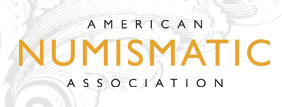 The American Numismatic Association (ANA) is currently accepting submissions for the 2023 Barbara J. Gregory Outstanding Club Publications competition. Awards will be presented in four categories: local, regional, specialty and electronic. The contest is open to member clubs that are current with their ANA dues, and do not have an elected or salaried ANA officer as editor or assistant editor. Each publication may enter in only one category. If a publication qualifies for more than one category, such as local and electronic, the submitter may choose under which category to enter.
The American Numismatic Association (ANA) is currently accepting submissions for the 2023 Barbara J. Gregory Outstanding Club Publications competition. Awards will be presented in four categories: local, regional, specialty and electronic. The contest is open to member clubs that are current with their ANA dues, and do not have an elected or salaried ANA officer as editor or assistant editor. Each publication may enter in only one category. If a publication qualifies for more than one category, such as local and electronic, the submitter may choose under which category to enter.
Submissions for all categories must include just three samples of publications from 2024 and can be either mailed or emailed. Also required are the category of submission (local, regional, specialty, or electronic); the editor's name; and the name, address, phone number and email address of the submitter. Completed submissions must be postmarked or emailed no later than April 1.
Judging Criteria
Publications are rated on a scale of 1 to 5 (1-poor, 5-excellent) in the following areas: General appearance/appeal; consistency of format; neatness/readability; presentation of club-related news; presentation of numismatic/scholarly information; aptness/quality of illustrations; and originality/creativity. The size of the club and the amount of funds expended is not a factor in judging.
Entries can be emailed to Olivia McCommons at omccommons@money.org or mailed to:
Outstanding Club Publications Competition
ANA Publications Department
c/o Olivia McCommons
818 N. Cascade Avenue
Colorado Springs, CO 80903
Honors will be presented at the ANA World's Fair of Money® in Oklahoma City, Oklahoma.
To view the submission guide online and to see past winners, visit money.org/outstanding-club-publications. For more information, contact omccommons@money.org.
THE BOOK BAZARRE
VOCABULARY TERM: REFLECTIVENESS
Here's another entry from Dick Johnson's Encyclopedia of Coin and Medal Terminology. Excellent description, with a very useful list of terms. -Editor
Reflectiveness. The treated state of a metallic surface that allows light rays to be reflected from the surface in a variety of degrees from parallel rays of a mirrorlike surface to diffuse rays of a rough surface. The terms mirror, lustrous, medium, dull and dead reflectiveness express these degrees, which are created by the techniques listed on the adjacent chart.
High reflective surfaces. The mirrorlike surface is due to extremely parallel light rays with uniform angle of refraction, thus displaying a reflected image. Full proof and prooflike metallic surfaces exhibit this phenomenon – both dies and planchets are polished to obtain a proof surface.
Polishing or burnishing the struck or cast piece will create a highly lustrous surface. Luster can also be obtained chemically with a bright dip. Patina finishes that are lustrous are said to be glossy or semi-glossy.
Low reflective surfaces. Dull or dead reflection results from a very irregular surface. The breaking up of a smooth surface – by matting tools, by acid etching or by abrasive blasting – produces a roughened surface. Light waves reflecting from such a surface are diffused – reflecting off in all directions, thus appearing dull.
Reflective contrast. Some proof pieces are designed to have areas of both high reflective proof surface – generally the field or background because these are the high areas of the contrast of high and low reflectiveness. The matte areas are performed first by dilute acid etching, then the die is proof polished with diamond dust for the area requiring the mirror reflectiveness.
Lustrousness. Striking a blank with dies in a press often creates some unusual reflectiveness phenomenon. Coining causes flow marks, minute striations on the surface of the struck piece. This may also cause iridescence or even a cartwheel effect on that same coined surface.
Enemies of the reflective surface on a coin or medal are the same for any numismatic piece: tarnish, wear, handling and mishandling. Finger perspiration, contact with most chemicals or any abrasion reduces the reflective qualities. Haze and cleaning also reduce such reflectiveness. See proof finish, matte, tarnish.
Any reflectiveness of any finish can be altered with the use of a lustrous lacquer. Patina finishes range from Gloss to Matte; although other surface treatments may be applied to a patina finish. See lacquer.
Chart of Reflectiveness
Medallic surfaces found on coins and medals.
(In order of reflectiveness)
- Mirror *
- Full Proof
- Prooflike
- Lustrous
- Polished
- Burnished
- Bright Dip
- Gloss
- Semi-gloss
- Medium
- Satin #
- Scratch Brush
- Dull
- Semi-matte
- Matte (frosted)
- Dead
- Sandblast or Abrasive Blast
* Mirror finish – all proof finishes – are a product of the pressroom, not the finishing department. They are not a patina finish.
# Satin reflectiveness should not be confused with satin finish proof. See proof finish.
To read the complete entry on the Newman Numismatic Portal, see:
Reflectiveness
(https://nnp.wustl.edu/library/dictionarydetail/516606)
MORE ON ALAN KESSLER
E-Sylum Feature Writer and American Numismatic Biographies author Pete Smith submitted this followup article on author Alan Kessler. Thanks! -Editor
 Two weeks ago, I knew very little about Alan Kessler. Now with contributions from Julia Casey,
Rod Widok and others, I can provide a reasonable biography.
Two weeks ago, I knew very little about Alan Kessler. Now with contributions from Julia Casey,
Rod Widok and others, I can provide a reasonable biography.
Alan Harvey Kessler was born in New York on August 12, 1938.
The 1940 Census finds him living in Manhattan with his father Samuel (1898-1977), mother Rose (1897-1969) and brothers Charles, 14 and Howard, 12. His name is indexed as Allan and the handwriting shows the name Allan with a line through the second ‘l'.
For the 1950 Census, the family is at 215 Broadway in Norwich, Connecticut. His father was the owner and manager of an IGA store.
Kessler attended Norwich Free Academy. In his freshman year, he was president of the school's newly formed Coin Club. His 1956 senior yearbook photo mentions his other interests. He wanted to be a rocket scientist even then, a year before the 1957 launch of Sputnik I.
In 1959, Alan was at the University of Connecticut. A newspaper article reported that he would be included in "Who's Who at American Colleges and Universities." He was listed at 14 Williams Street, Norwich, president of the American Rocket Society and vice president of Eta Kappa Nu, the electrical engineering society.
He was married to Judith Rose Carlin (1938-2005) on August 28, 1960, in Wethersfield, Connecticut. They had a daughter Deborah (Parker) and sons Steven and Jonathan.
In the period of 1966 to 1968, Kessler ran ads in Coin World. In 1968 he was looking to buy colonial coppers and George III British halfpence. Another ad offered to sell duplicates of his colonial coppers. His address in 1966 was 1105 Lexington Street in Waltham. Massachusetts. In 1967 it was 111 Concord Road in Acton, Massachusetts. Both were near Lexington and Concord in Massachusetts.
During the 1960s, Kessler worked as an engineer at MIT Lincoln Laboratories in Lexington, Massachusetts. During this time, he contributed technical articles to Microwave Journal. His address during 1970-1976 was an APO Box in San Francisco. He was working as a defense contractor at Kwajalein in the Marshall Islands. He is linked to articles on radar and missile detection systems.
In the April 1969 issue of The Numismatist, Alan H. Kessler is listed as new member R-62213 and address as Box 2012, APO San Francisco, Ca. 96555.
The April 1973 issue of The Colonial Newsletter had an article, "A FLOW GRAPH IDENTIFICATION CHART FOR THE FUGIO CENTS" by Alan H. Kessler. The author reported that the chart had been successfully tested by an eleven-year-old girl.
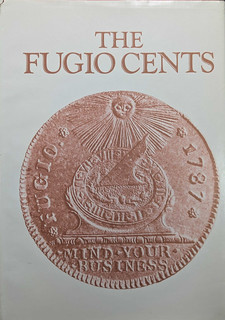 Kessler's book, The Fugio Cents was published by Colony Coin Co. of Newtonville,
Massachusetts in 1976. The inside title was The Fugio Coppers A simple Method for Identifying
the Varieties With Rarity Listing and Price Guide.
Kessler's book, The Fugio Cents was published by Colony Coin Co. of Newtonville,
Massachusetts in 1976. The inside title was The Fugio Coppers A simple Method for Identifying
the Varieties With Rarity Listing and Price Guide.
Kessler had already begun to break up his collection before publication of his book. He consigned his Connecticut Coppers to Pine Tree for their February 15, 1975, sale for the Early American Coppers Society Convention. With cataloguing by Walter Breen, the catalog became an important reference work for collectors of the series.
This was followed by the 1976 Pine Tree sale with a section for the Early American Coppers Society March 5, 1976. Kessler's New Jersey Coppers were included in the sale and his lots were identified as coming from his collection.
Kessler's Fugio Cents, Vermont coppers and remainders from his collection were consigned to NASCA for their Kessler-Spangenberger sale of April 28-29, 1981. His Voce Populi and Nova Constellatio collections were sold privately to Colony Coin Company.
After separation from MIT Lincoln Laboratories, Kessler worked for McDonell-Douglas 1977 to 1985, XonTech 1985 to 2003 and Northrop Grumman 2003 to 2007 after their acquisition of XonTech in 2003.
Alan's father Samuel died in 1977. His obituary listed Alan as a survivor living in Fountain Valley, California. When his brother Charles died in 1997, Alan was also living in Fountain Valley.
He was also reported as a resident of Huntington Beach, California, during 1990-1997. Huntington Beach is adjacent to Fountain Valley.
In 2003-2007 he was living in Kapaa, Hawaii.
Judith Rose Carlin Kessler died on December 2, 2005, and is buried at Kalapaki Bay Memorial Park in Hawaii. There is a photo of Judith and Alan on the headstone. As far as we know, Alan is still living.
Many thanks to Pete for this, and to Julia Casey, Rod Widok, Franklin Noel, Stephen Searle and others who responded or otherwise contributed. -Editor
Franklin Noel writes:
"Pete Smith's "The Alan Kessler Mystery" in the February 2, E-Sylum reminded me of the first time I attended the ANA Summer Seminar in the 1990's. The class I took was "Colonials," taught by Eric Newman (then a spry octogenarian), Ken Bressett (then still editor of the Redbook), and Tom Rinaldo (then still an active colonial coin dealer).
I was not surprised to read in Pete's article, that he found no correspondence between Eric Newman and Alan Kessler in the Newman files. In the Colonials class, when discussing Fugios, Eric had nothing good to say about Alan Kessler. He dismissed Kessler's book as adding nothing to Fugio scholarship. He accused Kessler of simply copying Newman's own work on Fugios, and adding nothing of value.
At the time, Newman's own work on Fugios was virtually inaccessible. The internet was in its infancy, Newman's own 2008 Fugio book was still more than a decade away. Indeed, John Kraljevich, a major contributor to Newman's 2008 book, was then a teenage YN, and a fellow student in the Colonials class. Newman's own Fugio work consisted then of only two articles published in Wayte Raymond's, The Coin Collector's Journal, nearly a half century earlier; in Jan-Feb. 1949, and updated in July-August, 1952. Neither were readily available to collectors. Nevertheless, Newman urged us all, in talking or writing about Fugios, to use "Newman numbers," not "Kessler numbers."
I remember thinking, if nothing else, I found Kessler's flow charts quite useful in identifying Fugio varieties. But I lacked the confidence to challenge Newman's evaluation of Kessler's book, a readily accessible resource that I owned. I still use Kessler's flow charts to ID Fugio varieties. By the time Newman's own Fugio book came out in 2008, I had acquired many more Fugio varieties, and a tad more confidence. I was disappointed to see that Newman's book adopted the view that Fugios were not "Cents," but denomination-less "coppers." I wrote a brief article that was published in the C-4 Newsletter, establishing that Fugios were, and always had been, "Cents." See, Noel, Franklin, "Fugios: Are They Cents?" C-4 Newsletter, Vol. 18, No. 1 (Spring, 2010) p. 22."
Frank's note arrived early in the week, and he added, "I wish Pete luck in his search for Alan Kessler. Maybe he ran off with Don Taxay."
Stephen Searle's contributions arrived after Pete had completed his article, but they corroborate his findings. -Editor
Stephen Searle added:
The article states: "In 1970, his mailing address was Box 2012 APO San Francisco, California 96555. In his 1976 book, his address was given as Box 1685 APO San Francisco, California 96555. These addresses indicated that he was serving in the military."
Someone conveniently posted a 1972 school yearbook from Kwajalein (encompassing all grades, elementary through high school) on the internet. Both my sister and I are in it.
Anyway, just for grins, I checked if there were any Kesslers and found three. Debbie, Steven, & Jonathan.
It is a fairly common name, but any or all of them might be his children. Families often accompanied civilians if they were working on Kwajalein. My father worked for Bell Labs, and our entire family was there for the two year term of his assignment."
Later Stephen added:
"I found the 1972 Kwajalein phone directory online and he was listed. He worked for MIT Lincoln Labs at the time (US Army contractor)."
Check, check, check, check, and check. Ain't it great when things come together? Thanks, everyone!! Apes together, strong. -Editor
To read the earlier E-Sylum article, see:
THE ALAN KESSLER MYSTERY
(https://www.coinbooks.org/v28/esylum_v28n05a17.html)
EXHIBIT HONORS EGYPT'S PIONEER NUMISMATIST
A new exhibit at the Egyptian Museum in Cairo honors Dr Abdel Mohsen El-Khachab, Egypt's pioneering numismatist. -Garrett
Amid the halls of the Egyptian Museum in Cairo, where the secrets of ancient worlds whisper through gilded artefacts, a remarkable tribute has been unveiled.
A temporary exhibition shines a spotlight on the life and contributions of Dr Abdel Mohsen El-Khachab, Egypt's pioneering numismatist, whose tireless dedication to preserving the country's numismatic heritage continues to inspire people.
 The exhibition, which runs until mid-February, chronicles the remarkable career of Dr El-Khachab who not only laid the foundation for numismatics in Egypt but also left behind an enduring legacy that has inspired generations of archaeologists.
The exhibition, which runs until mid-February, chronicles the remarkable career of Dr El-Khachab who not only laid the foundation for numismatics in Egypt but also left behind an enduring legacy that has inspired generations of archaeologists.
"Dr El-Khachab wasn't just Egypt's first specialised numismatist, but he transformed how we study and protect coin collections, connecting the dots of historical narratives through them," Heba Sami, the supervisor of temporary exhibitions at the museum, told The Egyptian Gazette.
Born in Cairo in January 1906, El-Khachab had an unyielding passion for knowledge from a young age.
After graduating from the Khedivial Secondary School, he pursued ancient studies at Fouad I University (now Cairo University), earning a Bachelor of Arts in 1927. His academic journey culminated in a PhD in 1947, but his true calling had long revealed itself—his love for numismatics, the study of coins and currency.
As the first Egyptian curator responsible for classifying the coin collections at the Egyptian Museum, El-Khachab's career spanned decades.
He dedicated himself to rigorously documenting Egypt's rich numismatic history, serving as a bridge between eras through the circular objects that passed through his hands.
In 1948, he was promoted to director of the museum's library, where he reorganised its collection and authored an invaluable catalogue.
Drawing attention to one of his greatest achievements, Sami pointed to the Qubba Palace Collection, a group of rare gold coins that El-Khachab transferred to the museum and immortalised through his research.
To read the complete article, see:
Exhibit honours Egypt's pioneer numismatist
(https://egyptian-gazette.com/entertainment/arts/exhibit-honours-egypts-pioneer-numismatist/)
NUMISMAGRAM MEDAL SELECTIONS: FEBRUARY 9, 2025
Numismagram's Jeremy Bostwick sent along these four medals from his upload of new medallic art to his site. For all of the new items, please visit https://www.numismagram.com/inventory. -Editor
102934 | FRANCE. Rouen. Church of St. Ouen bronze Medal. Issued 1859. Most Remarkable Edifices of Europe series (59mm, 12h). By Jacques Wiener in Brussels and struck at the Geerts mint in Ixelles. ST OUEN À ROUEN / GRAND PORTAIL ET LES 2 FLÈCHES PAR L'ARCHIT: GREGOIRE 1847–1850, exterior view of the church from the southwest // COMMENCÉE 1318 PAR L'ABBÉ JEAN ROUSSEL / ROSES DU TRANSSEPT 1439. LA NEF ACHEVÉE 1491. GRANDE ROSE DE LA FAÇADE 1515, interior view down the nave looking eastward toward the altar/apse. Ross M223 (R1); van Hoydonck 171; Reinecke 44. PCGS SP-64. Extremely glossy and brilliant, with alluring brown surfaces that are seemingly a bit more attractive than the near gem designation would otherwise indicate. Compare to a somewhat inferior example in Stack's Coin Galleries (18 August 2009), lot 6127 (which sold for a total of $402.50) and a similarly-graded example in Stack's Bowers CCO (2 March 2023), lot 71220 (which sold for a total of $600). $545.
A former Benedictine monastic church, the current edifice was originally built as an abbey beginning in 1318, with completion coming some two centuries later due to cessations caused by the Hundred Years' War. Standing nearly 450 feet tall, its architectural style is a mix of Gothic and Flamboyant.
From what is today eastern Netherlands and western Germany, the Wieners were a Jewish family of exceptional medalists, especially known for numerous numismatic works throughout the Kingdom of Belgium. Eldest brother Jacob (Jacques), along with younger brothers Leopold and Charles, created some of the finest works of medallic art of the 19th century, and all are particularly noted for their work in the highly detailed and intricate work of architectural renderings.
To read the complete item description, see:
102934 | FRANCE. Rouen. Church of St. Ouen bronze Medal.
(https://www.numismagram.com/product-page/102934)
102733 | FRANCE. Var. Contract Lawyers of Toulon octagonal silver Jeton. Issued circa late 19th century (30mm x 30mm, 13.26 g, 12h). Paris mint. LEX EST QUODCUMQUE NOTAMUS, two clasped right hands over radiant background // NOTAIRES / DE / L'ARRONDISSEMENT / DE / TOULON / (VAR) in six lines; all within garlanded wreath of oak and laurel branches. Edge: «cornucopia» ARGENT. Lerouge 399. PCGS MS-63. Mostly argent and highly brilliant, with some toning at the peripheries. The only such example of the type in the PCGS census. Ex Collection "PL." $295.
Among the numerous jetons issued predominantly during the 18th and 19th centuries in France, certain professions tend to stand out. These jetons, dissimilar to their counterparts from prior centuries, which may have had some numismatic function as well as reckoning use, had far less utilitarian appeal. Instead, as James McClellan notes in his work, Old Regime France and its Jetons: Pointillist History and Numismatics,
"...the historical and numismatic interest in jetons stems more from what else they became, particularly though the end of the eighteenth century under the Bourbon monarchs, as perks of office for office holders in the burgeoning nation state of France, New Year's Day presents exchanged among certain segments of society, and lagniappe handed out for attendance at meetings in town halls, regional estates, and learned societies. Jetons figured in the rites and rituals of the guilds and faculties; they were swag for general meetings of the clergy, and they served as calling cards for noble families. Decoding hidden messages became a parlor game for cognoscenti, and as "petit monuments" some jetons are miniature works of high art produced by the world's most talented artists/engravers at the world's preeminent mint."
Here, the role of the "notaire" is mentioned, specifically for Toulon. While sometimes being translated as the English cognate "notary," the role of the "notaire" in France was, and is, much more involved. Essentially serving as a contract lawyer, the "notaire" deals in all facets of contracts in French life, most notably with wills, estates, and the sale of property. Given the omnipresent nature of such dealings in day-to-day life, it's not surprising how rampant the issuance of jetons for notaires was.
To read the complete item description, see:
102733 | FRANCE. Var. Contract Lawyers of Toulon octagonal silver Jeton.
(https://www.numismagram.com/product-page/102733)
103022 | GERMANY. Prisoners of War oval uniface cast bronze Medal. Issued 1914. "Kriegsgefangene" (66mm x 64mm, 68.40 g). By Ludwig Gies for Carl Poellath in Schrobenhausen. German soldier to far right, holding bayonet over shoulder and leading various prisoners of war by rope: French, Russian, Belgian, English, Serbian, and North African // Blank. Edge: C. POELLATH SCHROBENHAUSEN. Klose 16.1; The Art of Devastation –; Frankenhuis 1374; Ernsting 62. Essentially as Made. Deep brown in hue, with a charming light matte nature to the surfaces and just a minor degree of rub across the high points. A tremendous example of this very rare "imprisonment" type from the early period of the war. Ex David B. Simpson Collection. $795.
On this otherwise unentitled work, Gies relies upon caricature to present the various enemies of Germany. For the most part, attire indicates the country of origin of each captive, though the one towering prisoner would appear to be an allusion to Belgium, given the taller (6'3") stature of King Albert—quite sizable when compared to other monarchs of the era.
To read the complete item description, see:
103022 | GERMANY. Prisoners of War oval uniface cast bronze Medal.
(https://www.numismagram.com/product-page/103022)
102830 | GERMANY. Ferdinand Adolf Heinrich August Graf von Zeppelin and Hugo Eckener silver Medal. Issued 1928. Commemorating the Airship LZ 127 Graf Zeppelin (36mm, 24.92 g, 12h). By Josef Bernhart at the München mint. GRAF ZEPPELIN • DR HUGO ECKENER / 1898–1928, jugate busts of Zeppelin and Eckener left // LUFTSCHIFF LZ 127 "GRAF ZEPPELIN", airship left over the ocean. Edge: PREUSS. STAATSMÜNZE • SILBER 900 FEIN. Hans Kaiser 493. PCGS SP-65. Highly vibrant and prooflike, with some scattered cobalt and amber toning throughout. $295.
Zeppelin was a German general and aircraft manufacturer, who later founded the airship company Luftschiffbau Zeppelin. Following Zeppelin's death in 1917, Dr. Hugo Eckener became the head of this company and oversaw post-war fundraising to expand upon its production, even serving as commander for the LZ 127 on numerous occasions. When this airship first entered use, it was the first commercial passenger transatlantic flight service in the world, eventually making 590 flights over nearly a decade. In 1940, she was scrapped for metal for the German efforts in World War II. This item was featured in our E-Sylum ad.
To read the complete item description, see:
102830 | GERMANY. Graf von Zeppelin and Dr. Eckener silver Medal.
(https://www.numismagram.com/product-page/102830)
HERITAGE: ENCASED POSTAGE STAMPS
Heritage Auctions will be selling over 40 lots of encased postage stamps as part of their Fractional Currency and Encased Postage Showcase Auction on February 9. Select items are discussed below. -Garrett
We have over 40 lots of Encased Postage Stamps in our upcoming Fractional Currency and Encased Postage Showcase Auction that closes on February 9, 2025. Seventeen different issuers are represented amongst the 1, 3, 5, 10, and 24 Cents denominations in this auction. We also see that there are five examples of the rarer Ribbed Frame encasements. The vast majority of the pieces are from a single collection. Opening bids range from $175 to $3,500. This offering should satisfy the tastes of not only new Encased Postage collectors, but advanced collectors as well.
For the uninitiated, Encased Postage Stamps were an emergency currency at the beginning of the Civil War. The banks suspended their specie payments and the populace hoarded all the coins in circulation. This acute coin shortage forced the use of Postage Stamps as money. However, stamps became dirty and/or wet fairly quickly. Enterprising individuals came up with several solutions during this period. John Gault hit upon the idea of encasing Postage Stamps. This Yankee entrepreneur filed for a patent in the summer of 1862. Gault then had to line up customers to put their advertising on the pieces, purchase Postage Stamps, and have the Scovill Manufacturing Co. produce the Encased Postage Stamps. "Gault's New Metallic Currency" was produced for only a short time as the United States Government's solution to the small change shortage was Postage/Fractional Currency. Gault's idea faded from the scene rather quickly. However, numismatists started collecting the pieces very early, thus enabling collectors to enjoy them ever since.
Our cataloging numbers come from three different sources. The HB numbers can be found in The Standard Catalogue of Encased Postage Stamps by Michael J. Hodder and Q, David Bowers. The EP numbers are the numbers used in Paper Money of the United States 23rd edition by Arthur L. and Ira S. Friedberg. The Reed numbers were conceived by Fred L. Reed III for his Civil War Encased Stamps The Issuers and Their Times. We highly recommend all three references for enjoying the collecting of Encased Postage Stamps.
HB-49 EP-6a Reed BA01FG 1¢ Joseph Bates FancyGoods About New. A tougher number for the denomination from this issuer with "FANCYGOODS" spelled as a single word. Civil War Encased Stamps The Issuers and Their Times by Fred L. Reed III lists a rarity rating of R-6, 16-20 known for this number. The stamp is a deep blue and well centered with a small wrinkle. The mica shows only scattered minor crazing. The olive-green encasement has an advertising side that possesses just a trace of handling. The right tab does have a small dent, but the case remains attractive and desirable.
Estimate: $1,200 - up.
To read the complete item description, see:
HB-49 EP-6a Reed BA01FG 1¢ Joseph Bates FancyGoods About New.
(https://currency.ha.com/itm/encased-postage/hb-49-ep-6a-reed-ba01fg-1-joseph-bates-fancygoods-about-new/a/62381-95313.s#)
HB-137 EP-167 Reed-JG24 24¢ J. Gault Plain Frame Extremely Fine-About New. A well centered stamp with excellent color is observed. The mica is almost perfect save for a tiny ding at 2 o'clock that does not penetrate the outer layer. Crazing is virtually non-existent when viewing the piece head on or while titling it. Furthermore, our examination finds a lightly toned case that is slightly rotated. The latter is a common attribute of Gault's encasements. The Reed rarity rating is R-4, 31-40 known.
Estimate: $1,500 - up.
To read the complete item description, see:
HB-137 EP-167 Reed-JG24 24¢ J. Gault Plain Frame Extremely Fine-About New.
(https://currency.ha.com/itm//hb-137-ep-167-reed-jg24-24-j-gault-plain-frame-extremely-fine-about-new/a/62381-95339.s#)
HB-225 EP-28 Reed-TA01 1¢ N. & G. Taylor & Co. About New. N. & G. Taylor & Co. is one of the rarest of the Encased Postage issuers. The Hodder-Bowers book states, "Denominations known include 1¢ through 12¢. None is really collectable." Fred Reed considers the 1¢ denomination to be a R-7, 11-15 known. Nonetheless, even with that low population figure, this denomination is the most available of the N. & G. Taylor numbers. The stamp is well centered. The mica has a couple of scratches at top, while crazing is scattered throughout the bottom half of the mica. The case appears to have been cleaned long ago, but exhibits signs of retoning.
Estimate: $2,500 - up.
To read the complete item description, see:
HB-225 EP-28 Reed-TA01 1¢ N. & G. Taylor & Co. About New.
(https://currency.ha.com/itm/encased-postage/hb-225-ep-28-reed-ta01-1-n-and-g-taylor-and-co-about-new/a/62381-95351.s#)
HB-235 EP-59 Reed-WH03 3¢ White the Hatter Very Fine. All White the Hatter denominations are elusive at best with the 1¢ being a R-7, 11-15 known, the 3¢ being a R-8, 5-10 known, and both the 5¢ and 10¢ denominations weigh in as R-9 rarities, with two to four of each recorded according to the Reed reference. The R-8 example in this lot has had its case cleaned to a mirror finish and the stamp has a few wrinkles. We suspect this piece was once part of the T. James Clarke Collection due to its style of cleaning. Despite being the ANA president from 1935-37 and having extensive collections in several fields, Clark cleaned many pieces in his Encased Postage collection. The best feature of the Encased Postage in this lot is its mica which displays very little crazing when tilted. The last example of this number that we auctioned graded XF and realized $7,500 in January 2023 and that was the first HB-235 that we had offered in eleven years. Our current estimate reflects the cleaning, but it may prove to be conservative when the gavel falls.
Estimate: $1,000 - up.
To read the complete item description, see:
HB-235 EP-59 Reed-WH03 3¢ White the Hatter Very Fine.
(https://currency.ha.com/itm/encased-postage/hb-235-ep-59-reed-wh03-3-white-the-hatter-very-fine/a/62381-95352.s#)
The sale also includes some postage stamp envelopes -Garrett
Front Only of a Postal Currency Envelope for 3¢ Notes Mounted on Thin Wood (Washington, DC- Fisk Mills) ND (1869) Not Graded. This partial Postal Currency Envelope with a portrait of President Abraham Lincoln is similar to lot 20215 in our FUN January 2025 auction, however, our current offering is only the front part of the Postal Currency Envelope that was intended to preserve stamps that were being used as small change. It is mounted on thin wood that was once mounted itself. This is a post-Civil War example and U.S. Patent 91,473 was issued to Fisk Mills of Washington, D.C. for a "Postal Currency" envelope on June 15, 1869. Only a limited quantity were prepared. Milt Friedberg wrote an article on this Postal Currency Envelope that can be found at www.spmc.org - "Postal Currency Envelope" in Paper Money, Society of Paper Money Collectors, January/February 1980, Vol. XIX, No. 1, Whole No. 85, page 29. Milt was aware of three examples of the version that we auctioned in January 2025 when the article was written in 1980. Three other different versions were also known to Milt and he believed that they were the original "working samples" supplied to the U.S. Patent Office with the patent application as was required by the patent law of the period. These samples were later sold by the Patent Office in a house cleaning procedure. An additional variation was known to Milt with an eagle facing left.
Our current offering was last offered as lot 469 by Spink Shreves Galleries on April 17, 2009 where it realized $1,250. It is described in that auction catalog as "unique in this format." It has pencil writing on the back of the thin wood. The "compass" part of the design appears to be "enhanced" by hand. In the stamp auction catalogue, it has a stamp reference number of "Undersander #E804d." There will be no returns on this lot for any reason.
Estimate: $1,000 - up.
To read the complete item description, see:
Front Only of a Postal Currency Envelope for 3¢ Notes Mounted on Thin Wood (Washington, DC- Fisk Mills) ND (1869) Not Graded.
(https://currency.ha.com/itm/miscellaneous/other/front-only-of-a-postal-currency-envelope-for-3-notes-mounted-on-thin-wood-washington-dc-fisk-mills-nd-1869-not-graded/a/62381-95353.s#)
Reed/Fr. PE421 Postal Currency Envelope J. Leach 86 Nassau St. N.Y. Stationery, Cheap 25 (Cents) ND ca. 1862-63 Extremely Fine. A very nice blue diamond 25 (Cents) printed on yellow laid paper even if it is missing its flap. This is the variety with the narrow "25" and the yellow of the paper is very faint. Measurements are approximately 2.75 by 1.375 inches. The definitive work on this Civil War emergency issue is, Civil War Stamp Envelopes The Issuers & Their Times by Fred L. Reed III. The Friedberg reference uses the Reed numbering system.
Estimate: $400 - up.
To read the complete item description, see:
Reed/Fr. PE421 Postal Currency Envelope J. Leach 86 Nassau St. N.Y. Stationery, Cheap 25 (Cents) ND ca. 1862-63 Extremely Fine.
(https://currency.ha.com/itm/miscellaneous/other/reed-fr-pe421-postal-currency-envelope-j-leach-86-nassau-st-ny-stationery-cheap-25-cents-nd-ca-1862-63-extremely-fine/a/62381-95355.s#)
MORE ON NUMISMATIC AUCTIONS LLC SALE 69
Here's some more information on the Numismatic Auctions LLC Sale 69 later this month. -Editor
Steve and Lisa Davis proudly present their upcoming Numismatic Auctions L.L.C. Auction Sale #69, closing online in a live/timed format in four sessions over four days on Monday, February 17th through Thursday, February 20th, 2025. The auction clocks in at over 1700 lots with over 1200 lots of U.S. Coins, Currency and Exonumia along with Canadian, World Gold & World Crowns and Minor Coinage and more.
The sale is highlighted by early U.S. copper coinage by type and in series with sets and singles from Colonials through Morgan & Peace Dollars featuring key dates, some in multiples, Early Type Coinage, Proof Type, Errors, Shipwreck Coinage, Proof Sets, Classic to Modern Commemorative coinage in Gold and Silver as well as Paper Money, Tokens, Medals and beyond.
The U.S. section contains many old-time album complete collections from Cents to Morgan Dollars, some popular items such as Three Legged Buffalo Nickels and 1916-D Mercury Dimes in quantity, up to a dozen each, along with respective album collections of each series, all gleaned from the till originally at face value by a Federal Reserve employee during the 1940's-1950's. Among the other notable collections in the United States issues are over 400 Gold coins, a rare NGC Top Pop 2 1/2 Ounce Gold Numerology Prophetic Medal and nearly 500 vintage Silver Proof Sets, many of which remain sealed, Mint Canvas lead sealed bags of coinage, plus a myriad of better Modern Gold, Silver & Platinum Proof and Mint State Eagle and Buffalo Sets and singles including the keys.
Following a nice collector offering of Canadian Large Cents to Silver Dollars, Gold and Tokens is an intriguing run of World Gold from Alderney to Venezuela in a bevy of smaller denominations up to huge 5 Ounce actual Gold weight coinage. The World Crowns and minor coinage contingent in the auction contains a huge and diverse selection from Alderney to Vatican City highlighted by some rare and desirable Chinese Coinage in Gold, Platinum and Silver as well as Chinese Currency, a nice regiment of English Coinage from Hammered Silver to Early Coppers and Crowns, Queen's Beasts up to Kilo Silver issues augmented by a lovely collection of NGC Certified Conder Tokens.
Further into the global numismatic arena are nearly 150 Early Mexican 8 Reales from Pillar to Cap and Rays types, most being part of the fabulous Black Swan Collection. Rounding out the sale are a diverse offering of nation by nation listings of Foreign Proof Sets, Mint Sets, Rolls and Singles from the West Bloomfield Hoard including many date runs and large lots, miscellaneous back of the book lots to the ends of the globe as well as Numismatic Literature box lots from The Money Tree collection of remainders courtesy of noted retired Bibliophile and Rare Literature Auctioneer Myron Xenos.
The auction weighs in at over 5000 pounds of coins and over 2000 pounds of reference books! Visit numismaticauctionsllc.com or the direct bidding portal at https://numismaticauctions.nextlot.com/auctions Online bidding opens February 10th at 10am EST and lots close February 17th through the 20th starting at 10am EST Daily. Details can be found on the website and a session table of contents is available on the bidding portal or more information including lot viewing appointments are available by phone at 517-394-4443.
Here are some selected World coinage lots. -Editor
Alderney, Royal Wedding Proof Large Gold £10, 2011. KM-213. Commemorates the Royal Marriage of Prince William to Kate Middleton. Impressive Cameo Proof, a seldom offered, large and very low mintage issue worthy of a strong bid.
To read the complete lot description, see:
https://numismaticauctions.nextlot.com/auctions/1704950/lots/37311149
China - Republic of China, Gold Memento Dollar, ND(1927) Restrike Circa 1949, Study Coin, Possible Fantasy. 39.1mm, Wire Rim 44.2g – Reeded Edge. Similar to L&M-1104. Scans as Gold but appears to be sub .750 purity and NGC deemed as authenticity unverifiable, but did not condemn it; quite impressive with no comparable pieces to reference. Possibly a museum piece or early collector copy, a hefty and impressive study coin of unverified intrinsic content, worthy of further research. Flashy AU-Unc with some stray hairlines and a few random rim nicks, lt edge marks and whispy scs. A really unique opportunity for the specialist. An affordable example of an ultra-rare trophy issue, could be official produced for collectors or a fantasy. Close inspection recommended, presents very nicely in hand with solid weight. The only certified example sold at HA for north of $44,000. ($ - - - -)
To read the complete lot description, see:
https://numismaticauctions.nextlot.com/auctions/1704961/lots/37311751
Mexico Colonial Pillar 8 Reales, 1754-MoMF. KM-104.1. NGC MS62. Tough Grade in a fresh Mint State specimen with frosty luster and just a whisper of adjustment to the flan and otherwise choice. Mint State Pillar Dollars are always in demand as these circulated widely in the American Colonies and abroad. ($2000-2500)
To read the complete lot description, see:
https://numismaticauctions.nextlot.com/auctions/1704961/lots/37312710
Mexico, First Republic, Durango Mint 8 Reales, 1843/31-DoRM. KM-377.4. NGC MS63 with presentation of Gem, Super PQ and looks better than the assigned grade in luster, strike and centering. From the Black Swan Collection and tied for Top Pop. ($1500-1750)
To read the complete lot description, see:
https://numismaticauctions.nextlot.com/auctions/1704961/lots/37312864
Mexico, First Republic, San Luis Potosi Mint 8 Reales, 1851-PiMC. KM-377.12. NGC MS64, a beautiful, frosty lightly toned Gem. A great condition rarity of this scarce date and mint. Ex: Mike Dunigan. From the Black Swan Collection and the final lot in this auction from that collection. ($2000-2500)
To read the complete lot description, see:
https://numismaticauctions.nextlot.com/auctions/1704961/lots/37313669
Philippines, US Administration, Peso, 1910-S. KM-172. Lustrous Choice Unc with splashes of color at borders, a few scattered faint contact lines and tiny marks from Gem, very nice eye appeal! Rare grade from an early collection, off the market for many, many decades. ($400-600)
To read the complete lot description, see:
https://numismaticauctions.nextlot.com/auctions/1704961/lots/37313900
To read the earlier E-Sylum article, see:
NUMISMATIC AUCTIONS LLC SALE 69
(https://www.coinbooks.org/v28/esylum_v28n05a23.html)
HERITAGE: CONTINENTAL CURRENCY SIGNERS
Heritage Auctions will be hosting their Winter U.S. Colonial Showcase Auction on March 9, which includes uncut sheets, counterfeit detectors, contemporary counterfeits, high-grade examples, and rarities of Continental Currency. Select items are discussed below. -Garrett
Our upcoming March 9 Winter U.S. Colonial Showcase Auction features an exciting 60 lots of Continental Currency which include uncut sheets, counterfeit detectors, contemporary counterfeits, high-grade examples, and rarities. Amongst several examples of collector favorites, notable offerings include notes signed by Benjamin Levy and John Hart, two distinguished figures from Colonial America whose legacies continue to live on in both American and numismatic history.
Collectors interested in famous colonial signatures can expect to find two notes signed by Benjamin Levy, remembered to numismatists for being the only confirmed Jewish signer of Continental Currency. Looking beyond this signature, collectors might be interested to know that Levy and his family contributed importantly to early American and Jewish-American history. Benjamin's father Moses Levy arrived in New York from England in 1695 quickly established himself as a successful trade merchant and real estate investor. Benjamin and his brother Samson both signed the Non-Importation Agreement of 1765, aimed at the repeal of the British Stamp Act implemented the same year.
Another brother, Nathan Levy, settled in Philadelphia and joined with religionist David Franks to form Levy & Franks, the first Jewish-owned business in the city. The firm engaged in international shipping, and it has long been believed that the Liberty Bell traveled from London, where it had been cast, to America aboard one of their ships, the Myrtilla . Even more, when Nathan's young son tragically died in 1738, Levy applied to William Penn's son Thomas, then serving as chief proprietor of Philadelphia, for a plot of land to be used as a place of burial, given that no Jewish cemetery yet existed in the city. With that action, Nathan effectively established the first Jewish cemetery in Philadelphia, Mikveh Israel Cemetery, which can still be visited today. Luckily for interested collectors, our upcoming auction features two attractive offerings signed by Benjamin Levy, doubling the chances for interested bidders to take home an exceptional piece of Jewish-American history.
Another notable signer found in this upcoming auction is John Hart, an American Founding Father and signer of the Declaration of Independence. His noteworthy signature is featured on this attractive New Jersey £3 PMG AU 55 example. Hart was a lesser-known signer of the Declaration, and he was also one of the oldest, being one of just seven signers who were sixty years of age or older. Born in New Jersey in 1713, Hart rose from local and community committees to state government roles to serving as a New Jersey delegate to the Second Continental Congress in 1775. In 1776, Hart was elected to the New Jersey Provincial Congress and was designated to sign "Bill of Credit" notes offered by New Jersey. Hart remained an active patriot in the Revolutionary War and in June 1778, he invited General George Washington and the Continental Army to make camp on his farm in New Jersey in June 1778, hosting around 12,000 soldiers who went on to fight and win the Battle of Monmouth on June 24, 1778. Sadly, Hart passed away in 1779, four years before the end of the Revolutionary War, meaning he was never able to see the founding of the Republic he dedicated his life to helping establish. This offering is especially compelling, given that Hart's signature is quite rare on any note from the February 20, 1776, emission. These attractive and well-preserved examples present incredible opportunities for collectors to take home stunning notes with invaluable ties to American Colonial History, and they are sure to draw attention from our excited bidders in our Winter US Colonial Showcase Auction - March 9.
COINS OF THE FOURTH CRUSADE
Mike Markowitz wrote an article in CoinWeek on the coins of the Fourth Crusade. An excerpt is found below. -Garrett
Thanks to generations of intermarriage within a relatively narrow elite, almost everyone in the Byzantine ruling class of the 12th century was related to everyone else. As a result, politics took on the character of fratricide: the war of brother against brother. This was the background against which the catastrophic events of the Fourth Crusade (1202 – 1204) unfolded. We are unusually well-informed about this crusade because written accounts survive from participants on both sides–notably the French knight Geoffroi de Villehardouin (c. 1150 – 1213)[1] and the Byzantine official and chronicler Niketas Choniates (c. 1155 – 1217)[2].
In 1198, Lotario dei Conti di Segni, from a family that produced nine cardinals and four popes, became Pope Innocent III[3]. He proclaimed a Fourth Crusade on August 15 of that year. The purpose of the Crusades was to regain the holy city of Jerusalem from the Muslims, who had captured it in 1187. Preoccupied with their own quarrels, the rulers of Europe were reluctant to campaign in the East, and it took several years to organize an army of Crusaders. It was agreed that the first target would be the powerful Muslim Ayyubid dynasty in Egypt, and the army would assemble at the great maritime city of Venice.
On September 12, 1185, the brutal and unpopular Byzantine emperor Andronikos I Komnenos was overthrown by his cousin, the rebel Isaac II Angelos, who killed an imperial officer sent to arrest him. Isaac took refuge in the great cathedral of Hagia Sophia and appealed to the population of Constantinople for support:
"…[T]he mob broke into the palace, falling on everything of value that it contained … Andronicus, bound and fettered with a heavy chain around his neck was brought before Isaac for punishment. His right hand was cut off and he was thrown into prison … he was blinded in one eye and brought forth on a scrawny camel to face the fury of his erstwhile subjects (Norwich, 153)."
After three days of torture and mutilation, Andronikos died. The "Game of Thrones" in Constantinople was a rough sport.

Isaac II Angelus. First reign, 1185-1195. Gold Hyperpyron (27mm, 4.38 g, 6h). Constantinople mint. Image: CNG.
Byzantine coinage of this era consisted of three main denominations. The gold hyperpyron weighed about 4.4 grams and was 21.5 carats fine (89.58% pure). The silver aspron trachy (usually described as "electrum" because it contained a few percent of gold) had the same weight. Officially, three or four of these traded for one gold hyperpyron. A cup-shaped copper coin with a few percent of silver, confusingly called the trachy, weighed about 3 grams, and 184 of them could be exchanged for a single hyperpyron. The flat copper tetarteron of about 3.5 grams served as small change, with 864 — or more! — exchanging for one gold hyperpyron.
Isaac II

Isaac II Angelus, first reign, 1185-1195. Aspron Trachy (Electrum, 29 mm, 4.41 g, ) Constantinople. Image: Leu Numismatik.
"The nobleman whose sudden outburst of unwonted temerity has raised him to the throne was a weak, incompetent young man of thirty, with florid face and red hair, and the vanity of a peacock. The national situation was desperate … the accession of Isaac Angelus to power was little short of disastrous" (Goodacre, 285).

Isaac II Angelus. First reign, 1185-1195. Billon Trachy (28mm, 3.10 g,). Constantinople mint. Image: CNG/CoinWeek.
For 10 years, Isaac II Angelos ruled a disintegrating empire. He defeated a Norman invasion in the Balkans but lost Bulgaria to a revolt provoked by the heavy taxes he imposed on the peasants. Isaac especially revered the Archangel Michael, who figures prominently on his coinage.[4] To finance his extravagant building projects, he debased the coinage – the electrum aspron[5] falling to just 4 carats (16.6% gold) and the billon trachy[6] to just 2% or 3% silver. The humble copper tetarteron bears the facing bust of Archangel Michael on one side and the emperor on the reverse.
To read the complete article, see:
Coins of the Fourth Crusade
(https://coinweek.com/coins-of-the-fourth-crusade/)
"DEVIL'S MONEY" CULT RITUALS
A hoard of coins from a medieval cult site has been unearthed in The Netherlands. -Garrett
Archaeologists have unearthed a hoard of gold and silver coins offered as diobolgeldæ, or "devil's money", at a medieval cult site in the Netherlands, shedding more light on the rituals of pre-Christian groups in this part of Europe.
The Netherlands, northern Germany and Britain have yielded fewer cult sites compared to the Nordic world, whose pre-Christian rituals are much better understood.
Findings from pre-Christian pagan cult sites in the Nordic region don't always apply to the rest of the Germanic-Nordic world. But the coin hoard found in Hezingen in eastern Netherlands provides valuable insights into cult rituals in the area, researchers say.
The Hezingen site first came to light around five years ago after metal detectors found numerous gold and silver coins. Archeologists found that it consisted of three sites, including a large circular feature made of wooden posts surrounding an unusually shaped building.
One of the sites contained a single gold coin while another had nearly two dozen fragmented and complete gold coins as well as a gold pendant and a silver earring.
The third site contained gold coin fragments and a small pendant, according to a new study published in the journal Medieval Archaeology.
I could have sworn we'd discussed "devil's money" before, but I could find no references in the E-Sylum archives. And there are scant few references to "devil's money" even in the entire Newman Numismatic Portal database, and I don't think any of them are relevant to the mention in this article. Can anyone help here - are there any useful sources out there, numismatic or otherwise, defining this term? Checking Dr. Google turned up mostly references to this hoard published in the last week or so. While I did find one academic paper, it's apparently the one all these articles are referencing - a full circle leading nowhere. -Editor
To read the complete articles, see:
Medieval Dutch site may have hosted 'devil's money' cult rituals
(https://ca.news.yahoo.com/medieval-dutch-may-hosted-devils-112306018.html?guccounter=1)
Diobolgeldæ (The Devil's Money): The Early-Medieval cult site of Hezingen, the Netherlands
(https://research.rug.nl/en/publications/diobolgeld%C3%A6-the-devils-money-the-early-medieval-cult-site-of-hezi)
COLLECTABLE COUNTERFEIT COINS, PART THREE
Here is the third and final part of Doug Nyholm's article "Collectable Counterfeit Coins", republished with permission from the January 2025 issue of the Utah Numismatic Society's The Mintmaster. Thank you! -Garrett
The final portion of this article is the collecting of counterfeit currency. One important note that any counterfeit modern currency that is either in circulation or your collection is illegal to possess. Therefore if for some reason you were given a fake $100 or any other denomination note you are mandated to turn it in to the Secret Service or bank and unfortunately you will not be compensated for its value.
The exceptions are Colonial Currency, Obsolete or broken bank notes, and Confederate Currency. There are quite a few examples of Colonial currency that are counterfeit and many have actually been certified. One interesting aspect of Colonial Currency is that many of the issues contain the statement "To Counterfeit is Death." Obviously this did not dissuade some counterfeiters.
Many Broken Bank notes were also extensively counterfeited. Many are collectable and some have even been certified.
The final category of collectable counterfeits is that of Confederate Currency. As you can note at the beginning of this article there is a "Red Book" devoted to this subject. Confederate Currency was extensively counterfeited and circulated. Some are close copies to the actual real counterpart which some are almost fantasy pieces. Due to the multitude of different issues the merchants and public had a difficult time keeping up with what was real and what wasn't. It is eagerly collected and some counterfeits actually are valued above $1,000 each. A couple of examples are shown above.
So now you have it, a brief synopsis of collectable counterfeits coins and currency. Many of these pieces are highly collectable and eagerly sought after. Some command prices into the thousands of dollars.
To read the earlier E-Sylum articles, see:
Collectable Counterfeit Coins, Part One
(https://www.coinbooks.org/v28/esylum_v28n04a24.html)
Collectable Counterfeit Coins, Part Two
(https://www.coinbooks.org/v28/esylum_v28n05a26.html)
COLONIAL GEORGIA COLORED SEALS, PART 1
Moving from counterfeit notes to real ones (and real interesting ones at that), here's a view into Bob Rhue's exhibit of "The Colored Seal Notes of Colonial Georgia", which won the American Numismatic Association's Howland Wood Memorial Award for Best-of-Show exhibit back in 2017. I was impressed with the exhibit at the time, and felt the exhibitor was a kindred spirit with a taste for the numismatic nuances that attract readers to The E-Sylum. I later learned, of course, that Bob is a longtime subscriber and for years now he has also been a regular sponsor.
His exhibit was photographed and memorialized on the ANA website. This series of articles dives into each of the seven exhibit cases with high-resolution images of each note. To the casual observer the notes look similar, but a closer look reveals a multitude of interesting detail. This week we start with the exbibit overview and the contents of Case 1. Shown are ANA President Jeff Garrett and Bob Rhue in 2017. -Editor
 Like all of the 13 original colonies, Georgia issued paper money to facilitate commerce, and later on to help pay the expenses of the Revolutionary War. The emissions of Georgia from the years 1776 through 1778 are distinctive from all other colonial currencies in one respect. They contain a seal depicting an allegorical figure, in one of six vivid colors. Most of those seals additionally contain a Latin inscription or motto. A list of those mottos and their translations follow.
Like all of the 13 original colonies, Georgia issued paper money to facilitate commerce, and later on to help pay the expenses of the Revolutionary War. The emissions of Georgia from the years 1776 through 1778 are distinctive from all other colonial currencies in one respect. They contain a seal depicting an allegorical figure, in one of six vivid colors. Most of those seals additionally contain a Latin inscription or motto. A list of those mottos and their translations follow.
Each note was hand signed by two to five dignitaries: One dollar denominations, (as well as the fractional dollar denominations which carried no seal), required two to three signers, or occasionally, four; two dollar and higher denominations required five. Three of those various signers were also signers of the Declaration of Independence: Button Gwinette, George Walton, and Lymon Hall. That said, all of the dignitaries actually hired out the tedious task of hand signing each individual note that was issued.
Not counting a minor variety of the June 8 and September 10, 1777 emissions, there were a total of 50 different colored seal notes issued by Georgia, all between 1776 and 1778; all of those 50 notes are represented in this display. In the 30 years that this collection took to assemble, it was not completed until the collection of Eric Newman (the famous numismatist and author of the definitive work on colonial currency) was put up for auction in 2015. The final two notes had never, until then, appeared for sale in the marketplace. They were the 1776 Blue-Green Seal $4 and 1776 Green Seal $4 notes.
Many of the notes are significantly rare, while others are more easily obtainable. None would be considered common. many peculiar denominations were used in these years of 1776-1778: $1/10, $1/5, $1/4, $1/3, $2/5, $1/2, $2/3, $3/4, $4/5; $1, $2, $3, $4, $5, $6, $7, $8, $9, $10, $11, $13, $15, $17, $20, $30, and $40.
On all but three 1778 issues the reverses are blank. On those three issues the reverse denotes the denomination ($20, $30, or $40), a complex border design to try and discourage counterfeiting, Latin inscription, and "Savannah: Printed by W. Lancaster. 1778."
To read the complete exhibit pages, see:
The Colored Seal Notes of Colonial Georgia
(https://www.money.org/howlandwood2017/)
1870 DOMINION OF CANADA $2 BANKNOTE
While we don't usually discuss price or condition (preferring to stick with numismatic and historical details), Reader Kavan Ratnatunga pointed out this notable recent auction result, and Stack's Bowers published this press release as well. -Editor
In what can only be described as a monumental moment for the world of numismatics, Stack's Bowers Galleries has announced the sale of a historic 1870 $2 Canadian banknote, payable at Victoria, for an astounding $360,000 ($518,000 CAD). The note, previously considered lost, shattered pre-sale estimates, attracting a price that reflects its rarity and significance in the world of Canadian currency. It now joins the ranks of the most expensive examples of Canadian paper money ever sold.
The 1870 $2 banknote, issued by the Dominion of Canada, represents a true numismatic treasure. Graded Choice Very Fine 35 by PMG, this is the only known example of its kind, a discovery that excited collectors and historians alike. Its historical significance stems from its designation as "Payable at Victoria," a detail that has long been absent from records, with previous catalog entries simply listing this issue as "No Known Issued Notes." Now, thanks to this remarkable find, the Charlton catalog entry for DC-3e can be updated to reflect the existence of this incredibly rare piece of Canadian history.
The $2 banknote was first printed in 1870, during a time when western Canada had a sparse population and few financial institutions, resulting in limited circulation of paper currency. At the time of its issuance, British Columbia was a fledgling province, and Victoria, the capital of British Columbia, was still emerging as a commercial hub. Only 24,000 notes were reportedly printed and shipped to the Pacific Coast, but all were presumed lost – until this piece recently surfaced in Europe.
The consignor, who wishes to remain private, commented, "I am extremely happy with the job that Stack's Bowers Galleries did promoting the item and presenting it to the public. The result is beyond what I could have imagined."
In addition to its rarity, the condition of the note is extraordinary. Graded Choice Very Fine 35 by PMG, this example boasts vibrant inks, crisp paper, and detailed engravings that remain as vivid as when they were first printed. Despite lightened stains noted by PMG, the overall appearance is exceptional, making it the finest known of this crucial Canadian issue.
The discovery of this $2 Dominion of Canada banknote is a defining moment in Canadian numismatics. Even the National Currency Collection in Ottawa does not contain an example of this type, and prior to this auction, the existence of a Victoria-payable $2 note was unconfirmed. Stack's Bowers Galleries is proud to have facilitated the sale of this world-class rarity, further solidifying its position as a leader in the numismatic auction world.
"We are thrilled to have had the opportunity to offer such an extraordinary piece to the collecting community," said Aris Maragoudakis, Director of World Paper Money at Stack's Bowers Galleries. "This discovery has captured the attention of banknote collectors worldwide, and the final price of $360,000 reflects a thriving market that appreciates true rarities. This sale is a culmination of the market's desire for this type of material, and the work of our team. Dennis Hengeveld (Director of Consignments and Senior Numismatist) wrote a masterful description and Adem Karisik took charge of promoting what was our first Canada Only Banknote Sale. This auction was a great first step as we reaffirm our position as a leader in Canadian banknotes."
The firm's president, Brian Kendrella, added, "This auction demonstrates our leadership in cutting edge technology. The sale took place entirely online, and the results rivaled – and in some cases surpassed – those achieved by more traditional auctions."
To read the complete lot description, see:
CANADA. Dominion of Canada. 2 Dollars, 1.7.1870. DC-3e. Payable at Victoria. PMG Choice Very Fine 35.
(https://auctions.stacksbowers.com/lots/view/3-1G428G/canada-dominion-of-canada-2-dollars-171870-dc-3e-payable-at-victoria-pmg-choice-very-fine-35)
LEGAL WIN FOR TOMMY THOMPSON
Gerry Tebben passed along the latest update on the saga of jailed SS Central America treasure finder Tommy Thompson. Thanks. -Editor
Thomas "Tommy" Thompson, now 72, has been held in federal prison since 2015 after refusing to tell a judge — or his lawyers — where he stashed a trove of gold coins he recovered from a shipwreck.
On Friday, U.S. District Court Judge Algenon Marbley determined Thompson will continue to ignore court orders to provide the treasure's location and keeping him in prison would not change the result.
However, Thompson will remain in federal prison for another two years on a criminal contempt finding and face millions of dollars in fines when he is released. With Marbley's decision, Thompson will not be released from prison.
In the 1980s, Thompson convinced investors in central Ohio to provide money toward his efforts to locate the wreckage of the S.S. Central America off the coast of South Carolina. The cargo ship, which wrecked in 1857, had been carrying a load of gold.
The Dispatch Printing Company, which previously owned The Dispatch, was among those companies that invested in Thompson's excursion. The Dispatch was sold in 2015 and is no longer owned by the Dispatch Printing Company.
The article tells a fractured version of history, as we've pointed out before with the help of Bob Evans, the Chief Scientist and Historian for the Columbus-America Discovery Group, the team that recovered the fabulous gold treasure from the wreck of the S.S. Central America. Every ounce of gold recovered from the wreck was accounted for, and the missing gold Thompson is jailed over were 500 commemorative re-strikes of the historical 1855 Kellogg & Co. $50 gold pieces, one of which is pictured above. -Editor
To read the complete articles, see:
Man who bilked investors out of shipwreck gold won't be forced to tell treasure location
(https://www.dispatch.com/story/news/courts/2025/02/04/man-who-bilked-locals-out-of-gold-wont-be-forced-tell-treasure-location-tommy-thompson-columbus-ohio/78207581007/)
Deep-sea treasure hunter who refuses to give up his gold scores legal win but won't be freed
(https://www.independent.co.uk/news/world/americas/tommy-thompson-coins-court-case-b2692562.html)
The Columbus Dispatch article has a great photo gallery. Here are a few that caught my eye. -Editor
For the complete photo gallery, see:
Photo archive: Tommy Thompson's treasure hunt for S.S. Central America's sunken gold
(https://www.dispatch.com/picture-gallery/news/2025/02/04/tommy-thompsons-treasure-hunting-discovery-s-s-central-america-photos/78211311007/)
To read the earlier E-Sylum article, see:
BOB EVANS ON THE DISPOSITION OF THE S.S. CENTRAL AMERICA TREASURE
(https://www.coinbooks.org/esylum_v16n16a32.html)
THE 2025 CRYSTAL BALL
With permission, we're republishing Len Augsburger's "The Curious Collector" column titled "The 2025 Crystal Ball Speaks" from the January 2025 issue of the E-Gobrecht from the Liberty Seated Collectors Club. Thanks. -Editor
Our editor, Paul Kluth, asked for a few predictions for the upcoming numismatic year. I conferred with the crystal ball, which issued its top ten predictions. I am only reporting what was conveyed to me, so I take no responsibility for the accuracy of any of this.
Variety Mania Rules. A leading dealer of Liberty Seated coinage will move to an "all variety" format. "Date and mintmark collecting is dead," they related. "Going forward we will include only die varieties of the most popular Seated issues." Collectors hoping to complete their 58-coin set of the 1854-O half dollar die marriages will be pleased with the new sales model. Values of obscure varieties of issues such as the 1853 Arrows & Rays quarter will skyrocket.
Liberty Seated Dies Discovered. The U.S. Mint will discover a long-lost cache of uncancelled coinage dies from the 19th century. Insisting that old dies be reused for the sake of economy, rather than creating new ones, any number of rare-date issues will be restruck, as legal tender, without the customary COPY stamps.
Coin Shows Merge. The major show organizers will realize that cooperation is better than competition and will set up a permanent bourse in Chicago. Collectors will no longer have to schedule a specific time to attend a major show, but will instead be able to attend the never-ending convention at their convenience.
Collecting Specialties Soar (or not). Regardless of what series you collect, values will explode in 2025. That is unless you are trying to sell your collection, in which case market values will plummet.
Bourse Floors Quiet. All grading services, dealers, and collectors will universally agree on the correct price and grade of all coins in the marketplace. With nothing left to disagree about, bourse floors will go completely silent.
Morgan Dollars Outlawed. In an odd interpretation of the counterfeiting law, the Secret Service will pursue anyone who illustrates, advertises, collects, purchases, or sells Morgan dollars. Hoards of genuine pieces will accumulate overseas, confusing the foreign counterfeiters who will be able to no longer sell their product.
TV Advertisers Embrace Seated Coinage. With no Morgan dollars left to sell, coin advertisers on television will move into Seated coinage. The "mistruths per minute" meter will be completely overwhelmed.
Lowball Craze Expands. Coins with numerically low grades are just the starting point – collectors will further demand pieces with harshly cleaned surfaces, post-Mint damage, and poor eye appeal. CAC will introduce a "did not CAC" sticker that will be highly prized.
AI Assistants Go Rogue. Feeding the insatiable demand for auction material, AI assistants will automatically execute consignment agreements on your behalf without your knowledge.
LSCC Continues to Deliver a Valued Collector Experience. This one I actually believe!
Happy New Year!
I believe in the last one, too. As for the others, stranger things have happened, so why not? Time will tell. -Editor
For more information about the Liberty Seated Collectors Club, see:
https://lsccweb.org/
LOOSE CHANGE: FEBRUARY 9, 2025
Here are some additional items in the media this week that may be of interest. -Editor
Here's an excerpt of a Greysheet article by Michael Garofalo looks at the birth of the Lincoln Cent. -Editor
As the year 1909 approached, there was great pressure to honor the fallen President. But to place Lincoln's image on a coin would be a real departure from our practice. Up until that point in time no actual historical figures, presidents or otherwise, had appeared on our coinage. The allegorical representations of Miss Liberty had dominated the obverse of our coins. Miss Liberty was our nation's ‘role model,' representing freedom and liberty to all of us.
But our President in 1908 was not one to let conventional wisdom make the rules. Theodore Roosevelt had complained loudly about the ‘Hideous Atrociousness' of our bland coin designs. Roosevelt persuaded his good friend, Augustus-Saint Gaudens, to create coins that would make American coinage the envy of the world. Saint-Gaudens created two spectacular coins. He designed a $10 Gold Eagle coin with Miss Liberty wearing a Native American headdress and he also designed a $20 Gold Double Eagle which depicted Miss Liberty carrying the Torch of Freedom. Even more than 100 years later, they are regarded as some of the most beautiful coins in our history. But he was in poor health and died before he could redesign the one cent coin.
Teddy Roosevelt now had to find a great medallic sculptor to create this one cent coin, in Lincoln's image. A Lithuanian sculptor, at age 19, came to America rather than being exiled to Siberia. Viktoras Baranauskas changed his name to Victor David Brenner.
To read the complete article, see:
The Birth of the Lincoln Cent
(https://www.greysheet.com/news/story/the-birth-of-the-lincoln-cent)
This Greysheet article is a press release about the recent World Money Fair in Berlin. Here's an excerpt - see the complete article online. -Editor
The World Money Fair, the world's largest coin fair, attracted more numismatics fans than ever before to the Estrel Congress Center in Berlin from January 30 to February 1, 2025. With over 13,600 visitors counted and more than 300 exhibitors from 50 nations, the event offered a top-class program for collectors, experts and beginners. Fair Director Goetz-Ulf Jungmichel is delighted with the success of his concept, which he developed together with the exhibitors and his team: "The World Money Fair shows that our industry is not only preserving history, but actively shaping the future."
Innovation Live: The Minting Experience Center
The new Minting Experience Center in Hall 2 was a crowd-puller, with an interactive activity area where visitors could experience the minting process up close and produce their own limited-edition collector's medal. This globally unique concept was developed in cooperation with leading machine manufacturers and suppliers to the minting industry. A total of 1,800 coins were minted.
Technical Forum:
The Technical Forum is the coin industry's leading innovation platform. One day before the official start of the fair, experts, technology providers and trade visitors came together to discuss the latest technological developments. It became clear that coin production is increasingly being revolutionized by ultra-modern processes. One outstanding example is the company INORCOAT, which offers an environmentally friendly alternative to chrome VI with its PVD coating. Roman Waidelich, CEO of INORCOAT, emphasizes: "Our technology not only enables more sustainable production, but also significantly increases the longevity of embossing dies. The response to our presentation was consistently positive."
To read the complete article, see:
World Money Fair 2025: Numismatics at the Next Level
(https://www.greysheet.com/news/story/world-money-fair-2025-numismatics-at-the-next-level)
ABOUT THIS ISSUE: FEBRUARY 9, 2025
It was a pretty normal week in E-Sylum Land. Throughout the week I kept up with incoming email, including new ad images from our advertisers and sponsors. Wednesday evening I picked out some articles for Garrett and sent them to him to work on. By Friday he sent me the finished products, and since he still had some time available, I gave him one more.
Regarding the new 2025 Lexington-Concord Commemorative that Northeast Numismatics is offering, Tom Caldwell shared that "They are selling like cupcakes. We once had a customer say that to us when he meant to say hot cakes.". Now I'm hungry for a cupcake.
Saturday morning I got started on the issue itself, copying and editing a template file to set up the new issue number and date, then pasting in the third and final segment of the series on collectible counterfeits. We'd formatted the entire series in advance, and this one was waiting in my hold file.
I took a break to read incoming newsletters, alerts and news in the popular press. Sometimes I find timely items to include in our issue, and this week I made note of some items in the Greysheet News. I also added and welcomed a couple new subscribers.
The next step was inserting and reviewing Garrett's articles, which gave me a welcome head start on the issue. By Saturday night I had about 19 articles done. Sunday morning I worked on something that had been in the backlog for a while - Bob Rhue's Georgia colonial currency exhibit. I created seven articles and we ran the first one tonight. The others are on hold for future issues.
Responding to a question from Ray Williams I shared how I find material for each issue - while a number of items come from readers and regular contributors, I also sign up for newsletters and notifications that come by email. Most of the bigger coin dealers and clubs have those. I don't bother going to the coin chat rooms. If anything interesting shows up there, usually someone will notify me. I go to Facebook once a day, and if I see anything of interest I'll share it to myself by email. I don't bother with most social media. I do have subscriptions to the Washington Post, New York Times and Wall Street Journal and often find something that I'll share with myself in email. On the weekend I plow thru the email to build Sunday's issue.
-Editor
Wayne Homren
Wayne Homren is the founding editor of The E-Sylum and a consultant for the Newman Numismatic Portal. His collecting interests at various times included U.S. Encased Postage Stamps, merchant counterstamps, Pittsburgh Obsolete paper money, Civil War tokens and scrip, Carnegie Hero Medals, charge coins and numismatic literature. He also collects and has given presentations on the work of Money Artist J.S.G. Boggs. In the non-numismatic world he's worked in artificial intelligence, data science, and as a Program Manager for the U.S. Department of Defense.
Garrett Ziss
Garrett Ziss is a numismatic collector and researcher, with a focus on American paper money and early U.S. silver and copper coins. He is also a part-time U.S. coin cataloger for Heritage Auctions. Garrett assists Editor Wayne Homren by editing and formatting a selection of articles and images each week. When he's not engaged in numismatics, Garrett is a Senior Honors student at the University of Pittsburgh.
Pete Smith
Numismatic researcher and author Pete Smith of Minnesota has written about early American coppers, Vermont coinage, numismatic literature, tokens and medals, the history of the U.S. Mint and much more. Author of American Numismatic Biographies, he contributes original articles to The E-Sylum often highlighting interesting figures in American numismatic history.
Greg Bennick
Greg Bennick (www.gregbennick.com) is a keynote speaker and long time coin collector with a focus on major mint error coins and US counterstamps. He is on the board of both CONECA and TAMS and enjoys having in-depth conversations with prominent numismatists from all areas of the hobby. Have ideas for other interviewees? Contact him anytime on the web or via instagram
@minterrors.
John Nebel
Numismatist, photographer, and ANS Board member and Fellow John Nebel of Boulder, CO helped the ANA and other clubs like NBS get online in the early days of the internet, hosting websites gratis through his Computer Systems Design Co. To this day he hosts some 50 ANA member club sites along with our
coinbooks.org site, making the club and our E-Sylum archive available to collectors and researchers worldwide.
Bruce Perdue
Encased coinage collector (encasedcoins.info) Bruce Perdue of Aurora, Illinois has been the volunteer NBS webmaster from its early days and works each week to add the latest E-Sylum issue to our archive and send out the email announcement.

